Back in April we announced that Lucky Thirteen had acquired a top turret dome. This dome was in California and circumstances prevented us from getting it across the country to our hangar at that time.
But now she is here!
I drove up to finally see her in person, as well as give a tour to Tom and Robbi Perry of Greer, South Carolina (who seemed to have a wonderful time).
This is a truly monumental step for us. It is hard for me to imagine what my childhood self would think about what I am doing now, much less myself three years ago. The rate at which this project is building steam is incredible! This dome was donated to Hangar Thirteen through the incredible efforts of:
Keith Ellefson
Karl Hauffe
Ray Moore
Don Price
Andy Rivera
and Chris Wilkinson
To each of these guys, we cannot thank you enough! Chris in particular deserves special recognition for shepherding the turret dome effort. It was a ton of work but he was the one who made the idea a reality. Right now, electric motors and hydraulic transmissions for both turrets, with spares, are on their way here from California.
Considering its age, this dome is in exquisite condition. Originally, we had reported that it was a Type 1 dome, based on the arrangement of its window frames. This still holds true. However, Type 1 and Type 2 domes were also differentiated by manufacturer – Type 1s were made by Steel Products of Springfield, Ohio and Type 2s were made by Emerson Electric of St. Louis, Missouri. The serial number for this dome is an Emerson number, so technically, you might say that it is a Type 2. More likely, this dome was cast before Emerson altered the Type 1 pattern into the Type 2.
This serial number does provide us with an interesting bit of information: doing the math, we now know that this dome was made for the 99th Type A-1 upper turret produced by Emerson Electric.
Since we have always sought the highest standards of accuracy, we have never wavered from our goals to restore and/or rebuild every component to working condition. The B-17F’s turrets will be the ultimate test. A couple years back, we estimated that it would cost somewhere around $120,000 to rebuild the top and ball turrets. That may still be the case. We have purposely avoided sharing too much information on opportunities we have regarding turrets, but suffice it to say, we have the potential to purchase virtually everything for L13’s top turret. Likewise, while it is a certainty that a new ball will have to be cast, we have been offered an original ball turret hanger and trunnion assembly for $24,000.
Hangar Thirteen is blessed to have some incredibly talented and dedicated volunteers. I have no doubt that we can do these subjects justice. We just need your help to make it happen.
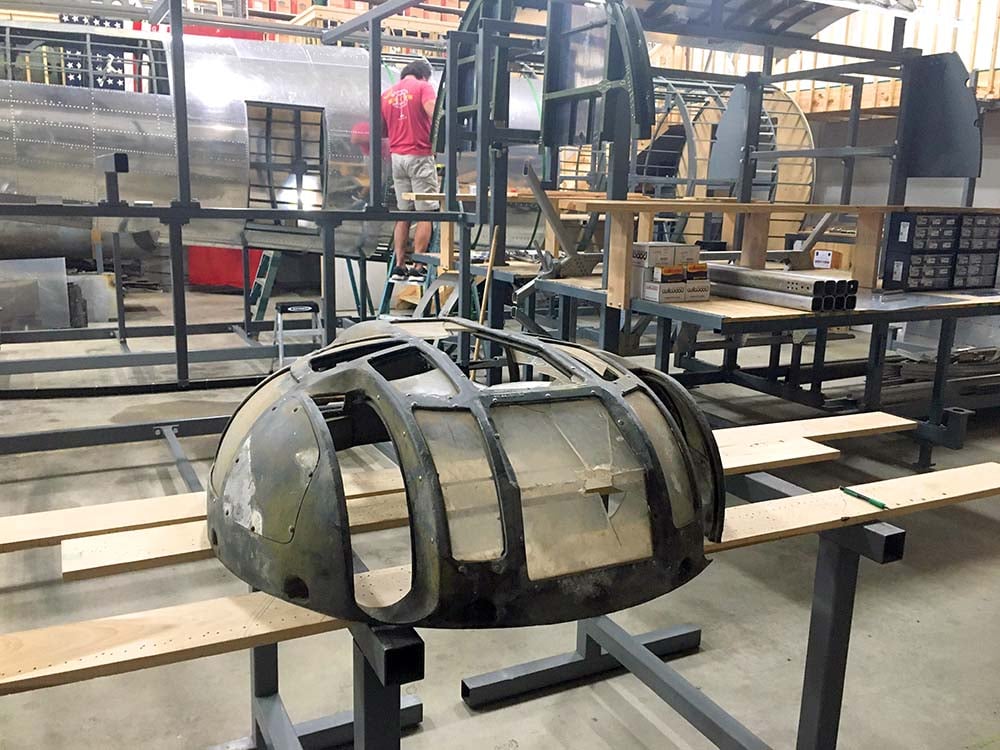
The newly arrived Type A-1 Upper Turret dome, sitting beside the fuselage jigs.
Photo taken 30 September 2021.
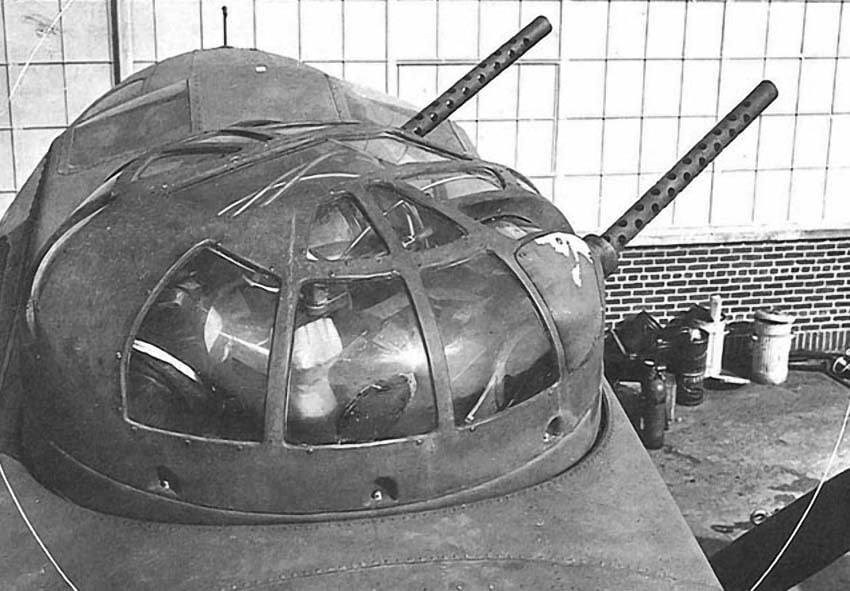
An early Type A-1 Upper Turret in service.
While the Type 1 and Type 2 dome are virtually indistinguishable, later domes were more varied. They were taller and usually featured bolted components for ease of access.
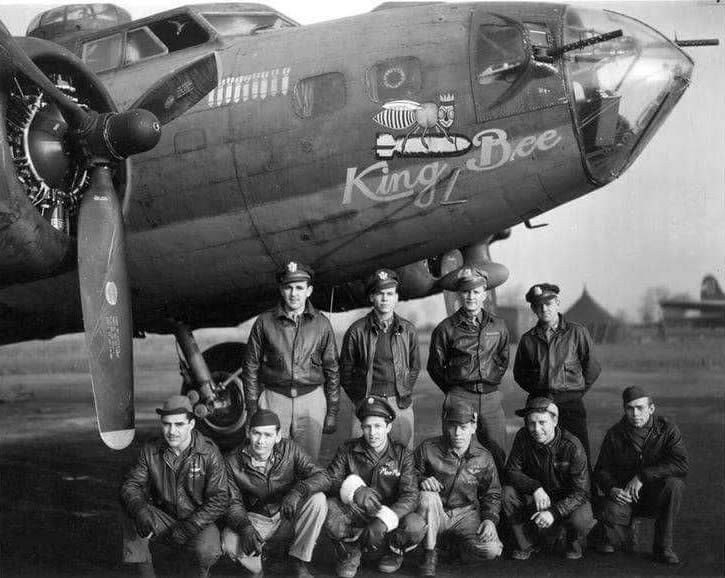
King Bee (42-3474, 100BG), a B-17F from the same Douglas production block as Lucky Thirteen. Note the early-style top turret dome.
King Bee was written off on 1 January 1944 after a crash-landing at Thorpe-Abbotts during a routine training flight.
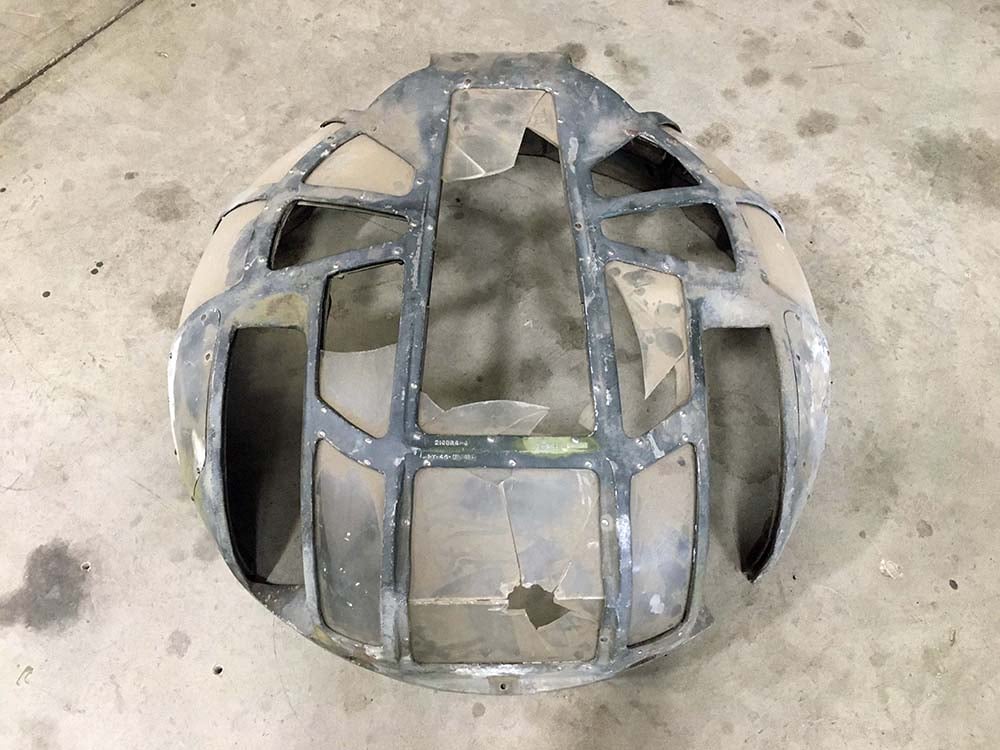
An overhead view of the newly-arrived early top turret dome.
The plexiglass is .25″ acrylic.
Photo taken 30 September 2021.

The underside of the newly-arrived early top turret dome.
The broken bit under the right dome is easily repaired.
Photo taken 30 September 2021.
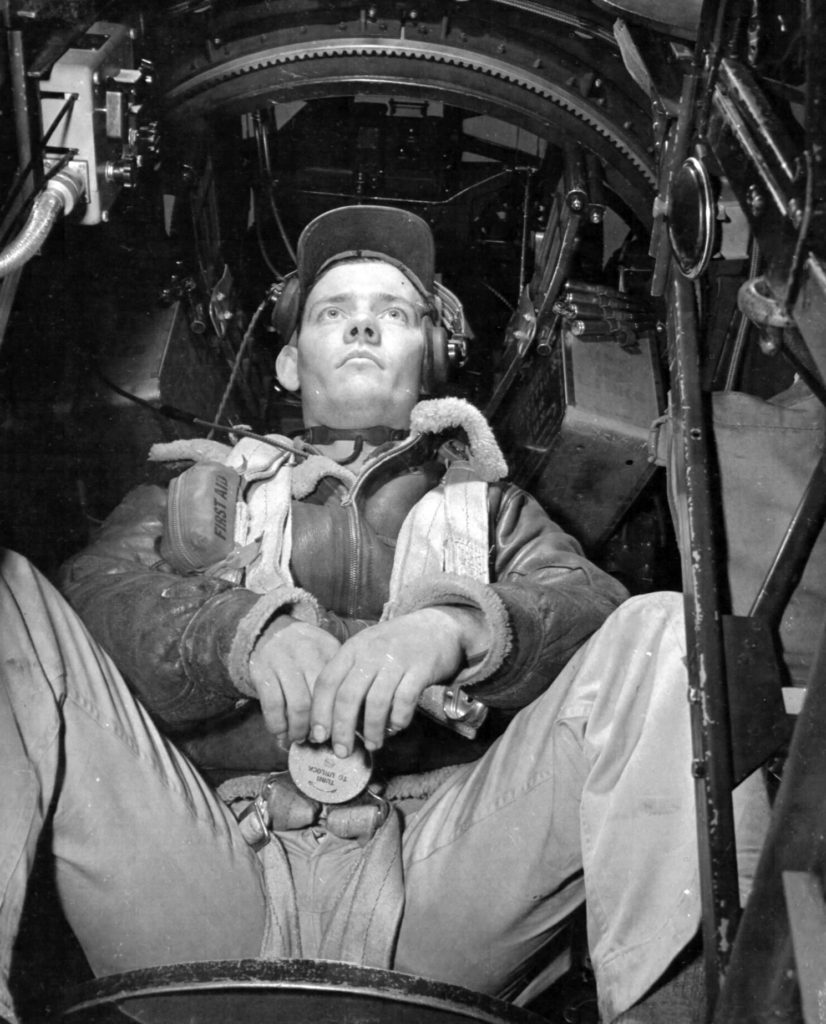
TSGT Dale W. Rice of the 303BG sits on the pedastal of Type A-1 Upper Turret.
Rice survived the ditching of Old Squaw (42-3002, 303BG) on 6 September 1943, one of several B-17s which ran out fuel that day. This was the same strike on which Lucky Thirteen was shot down, dropping out formation due to a fuel leak caused by anti-aircraft fire. An FW-190 intercepted her on the flight home.
Bob Hachmann recently completed 3D modelling the Type K-4 ball mount which was used in the nose gun position on Lucky Thirteen. Original examples of this mount are quite rare and expensive, which is why we were fortunate to get help from our friend Mike Stockton in the UK. Mike was super helpful, taking measurements and reference photos, and answering follow-up questions. Thanks Mike!
Originally, the F-model B-17 featured a pair of recesses in the upper portion of the nose cone, the idea being that the bombardier could move a .30 caliber MG between them. Overseas, these aircraft were usually altered to mount a .50 caliber MG, mounting a series of awkward braces to absorb recoil. The design used by Lucky Thirteen entered service in February 1943 and was a product of the Cheyenne Modification Center. With Boeing eliminating the recesses in the nose cone, (in favor of a smooth nose) the Cheyenne design cut a triangular hole in the center, mounting a single .50 caliber MG. Despite being the most common nose gun on F-model B-17s, no example currently survives today.
Unless you count our work on Lucky Thirteen.
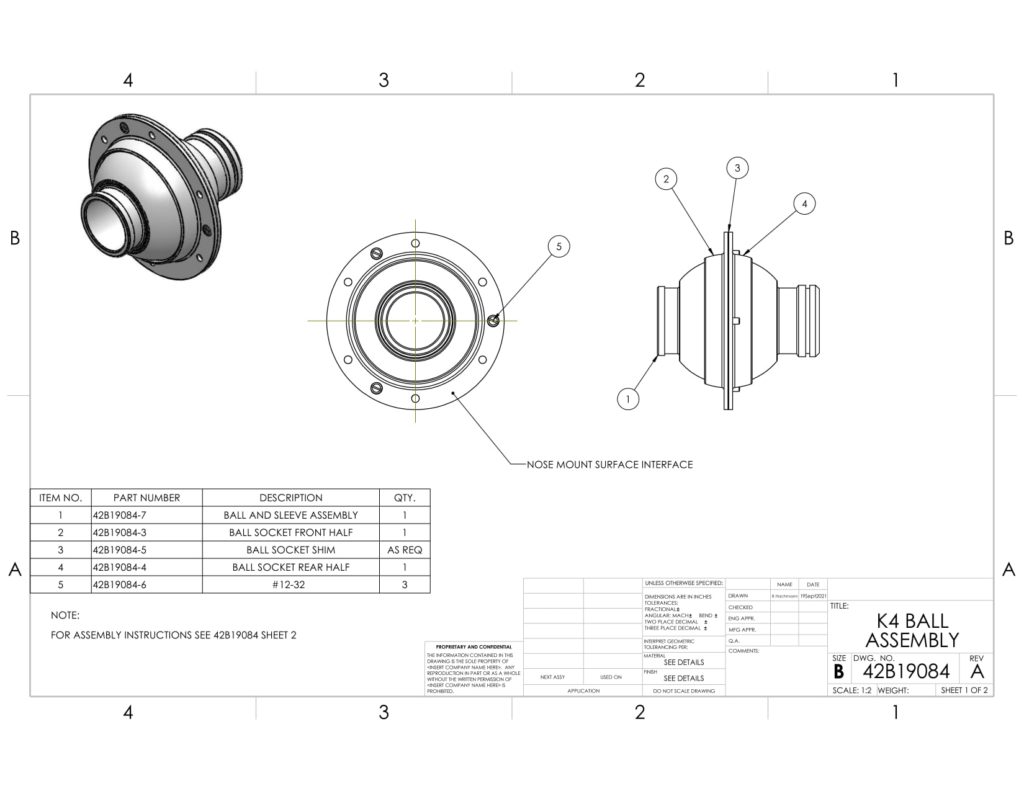
Bob’s master print for the Type K-4 ball mount.
A series of subprints (also by Bob) go into detail regarding measurements and composition.
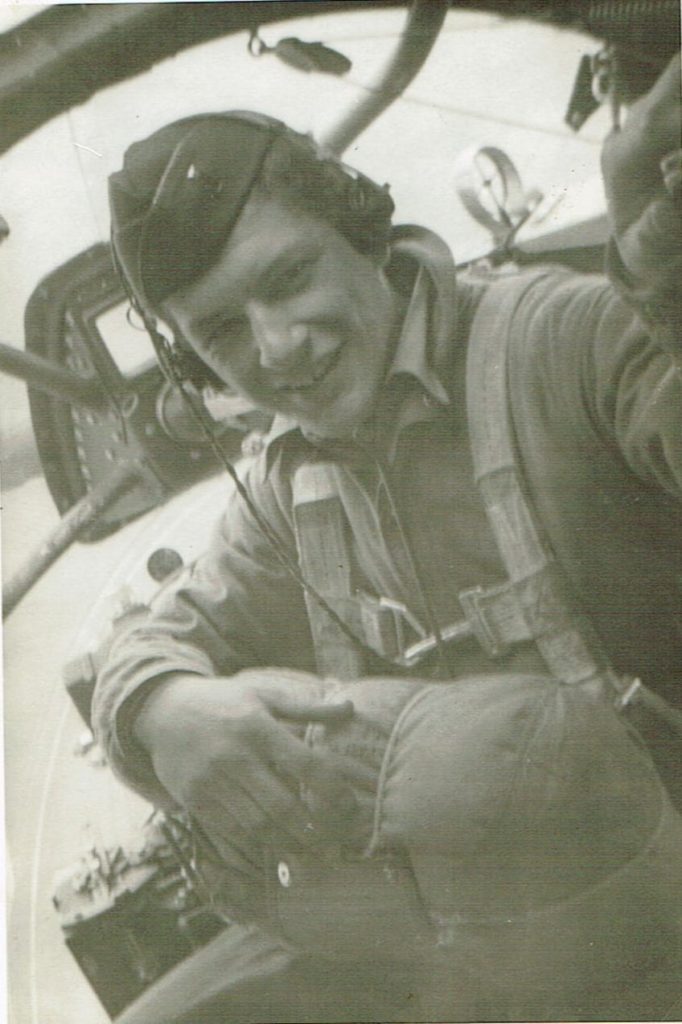
2LT Teddy Chronopolos (379BG) in training aboard a war-weary F-model.
Note the Cheyenne type nose mount, with the K-4 ball dead center.
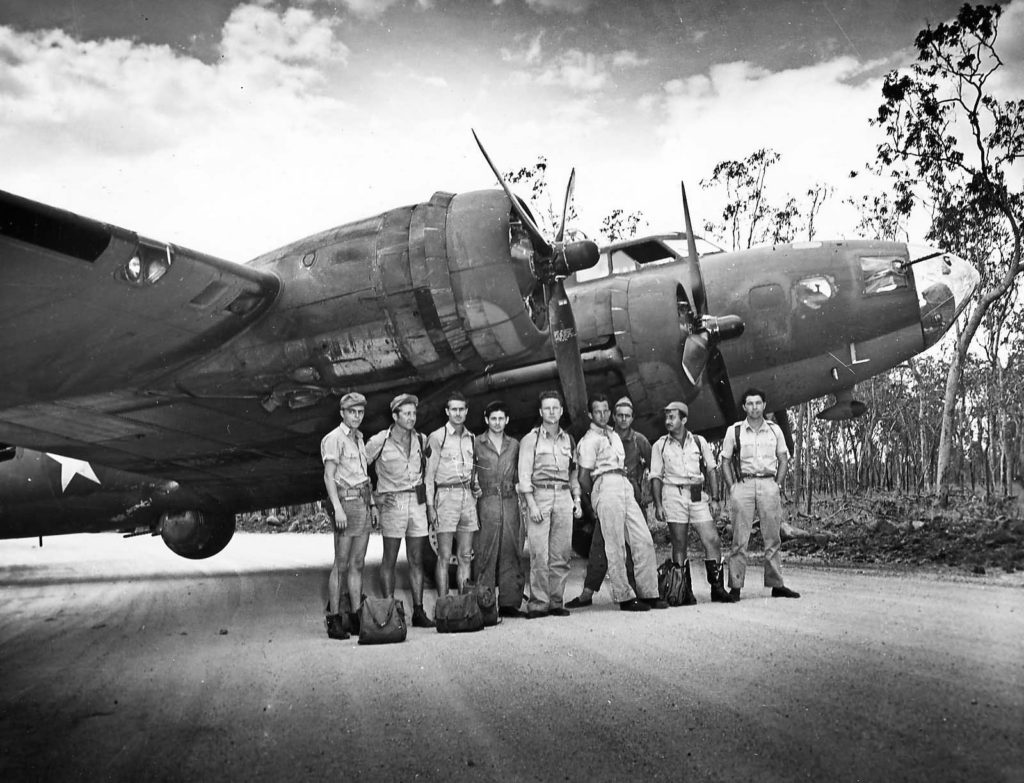
An early F-model B-17 with the 43BG (US 5AF) in Australia.
Note the recesses in the nose cone.
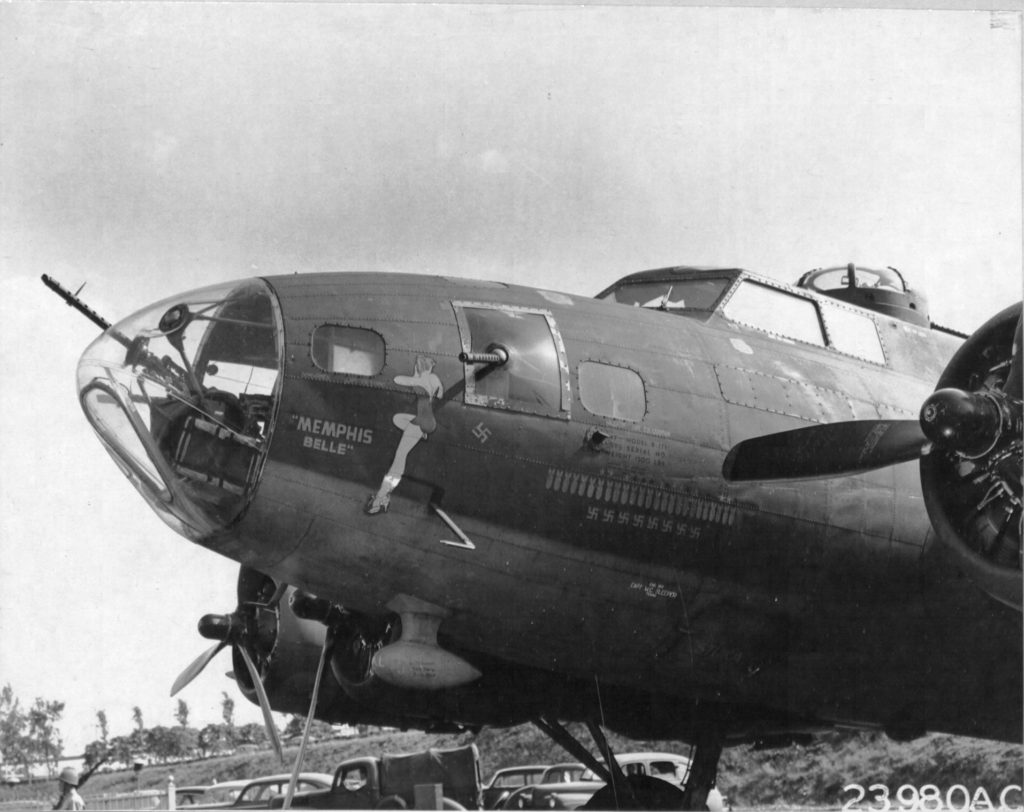
Memphis Belle (41-24485, 91BG) while on her stateside war bond tour.
Note the bracing in her nose to accommodate the .50 caliber MG. Despite bracing both recesses, aircraft with this arrangement generally only carried a single nose gun.
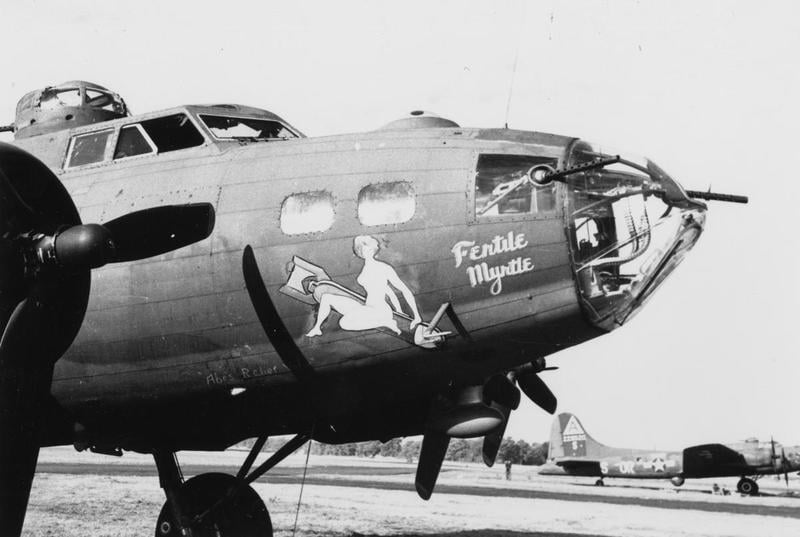
Fertile Myrtle (42-29520, 91BG), one of the first F-models to receive the Cheyenne type nose gun mount. This was the most common nose gun found aboard F-model B-17s, and was also the type used by Lucky Thirteen.
Fertile Myrtle was lost on 8 October 1943 over Bremen. Seven of her crew survived.

A rare Cheyenne drawing shows the installation of the triangular nose gun mount.
We were EXTREMELY fortunate to obtain an original box mount from our friend Colin Waterworth in the UK.
Back in August we received an inquiry in response to our feature in the 384BG newsletter. Kevin Davenport is an engineer in St. Johns, Florida who teaches CAD modelling and 3D printing at Creekside High School. His grandfather was 2LT Ben F. Wells, a bombardier with the 384BG (the same unit as Lucky Thirteen) who completed six combat missions before taken prisoner on 20 July 1944. Kevin wanted to know if his class could help with the project.
Of course!
Not knowing what kind of difficulty would be appropriate, I rattled off a series of ideas. All were accepted and we were surprised to find that our volunteer Bob Jacoby lived just minutes away, so they took on helping him as well. So far, these projects mainly entail CAD modelling various parts, but it is our hope that having these models ready to go might encourage more metal fabrication and casting volunteers to step forward.
To help visualize some of the pieces the students were working on, I suggested Kevin talk to our friend Jerry McLaughlin at the National Museum of the Mighty Eighth Air Force in Savannah, Georgia. They were happy to open City of Savannah up, so Saturday I drove down to meet Kevin and five of the students. (Since it was not an official field trip, the students came on their own accord.)
They had a blast. Museum volunteer Sam Currie walked the students through the airplane. I stayed behind and looked over some papers Kevin’s wife, Heather, brought that belonged to her father – a B-24 ball turret gunner with the 43BG (Fifth Air Force). The students stayed a particularly long time in the cockpit, carefully examining the structure of the seats, as that is one of Bob’s current projects. Upon noticing that a knob was missing on the controls, one of the students produced a 3D printed one from his pocket, eager to see if it would fit. It did.
These five are just a portion of the class. I must say that I was impressed with their enthusiasm and professionalism. Seeing the B-17 up close seemed to make a major impact. As the years go by, let us hope for more of the same. These are the ones who are going to inherit this history.

The students pose in front of City of Savannah (44-83814).
From left to right:
Nipun Warusawithana
William Bass
Brady Gannon
Garrett Alberts
Lauren Castillo
Kevin Davenport
and myself.
Photo taken 18 September 2021.
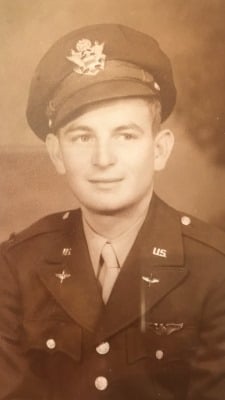
Kevin’s grandfather, 2LT Ben F. Wells.
Wells was imprisoned at Stalag Luft I near Barth in northern Germany. The site held some 9,000 Allied airmen prisoner. Stalag Luft I was liberated by Soviet forces on 30 April 1945 and the prisoners airlifted out 13-15 May.
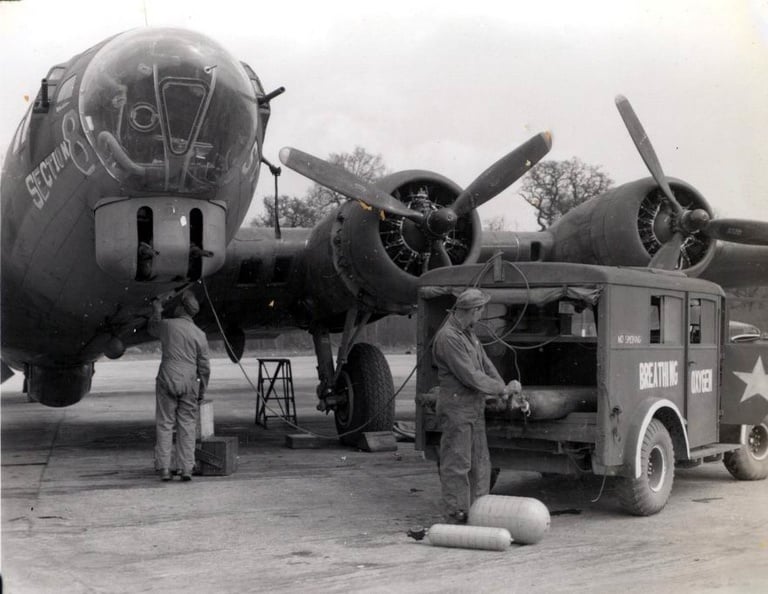
Section 8 (42-37974), the aircraft Wells was aboard when shot down over Zetteritz, Germany. The name refers to the military classification given to those deemed unfit for service due to mental disability.
This strike saw the 8AF launch 669 Boeing B-17s and 573 Consolidated B-24s, escorted by 144 Lockheed P-38s, 239 Republic P-47s, and 378 North American P-51s against Höllsriegelskreuth, Lechfeld, Ausburg, Kempten, Strasbourg, Leipheim, Laupheim, Ebelsbach, Schweinfurt, and Saarbrücken, Germany. This strike was launched during the period wherein USSTAF was under the direct control of SHAEF, bombing transportation hubs in support of the cross-channel invasion. This was a joint operation, with the 15AF in Italy launching 483 bombers and 342 fighters. The 8AF lost 17 bombers and 7 fighters, the 15AF lost 22 bombers and 5 fighters. German records acknowledge the loss of 23 interceptors.
Section 8 was lost when, unable to stay with the formation due to flak damage, she was shot down over Zetteritz. Eight of her ten man crew managed to bail out. This was the aircraft’s 42nd combat mission.
This photo shows ground crews recharging the oxygen system aboard Section 8.
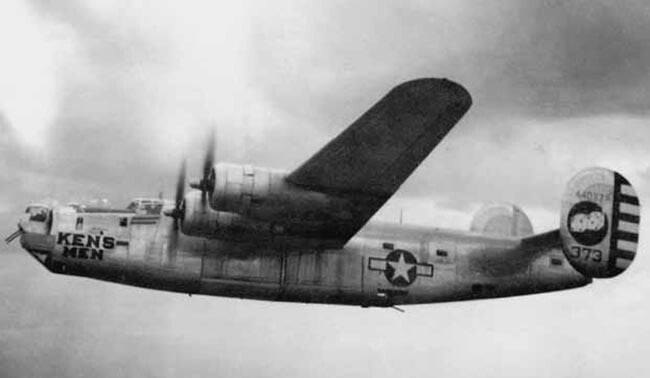
Ken’s Men (44-40806) of the 65BS/43BG. This is the same unit with which Heather Davenport’s father flew as a ball turret gunner.
Note how the ball turret has been retracted – a common practice on B-24s to cut down on drag.
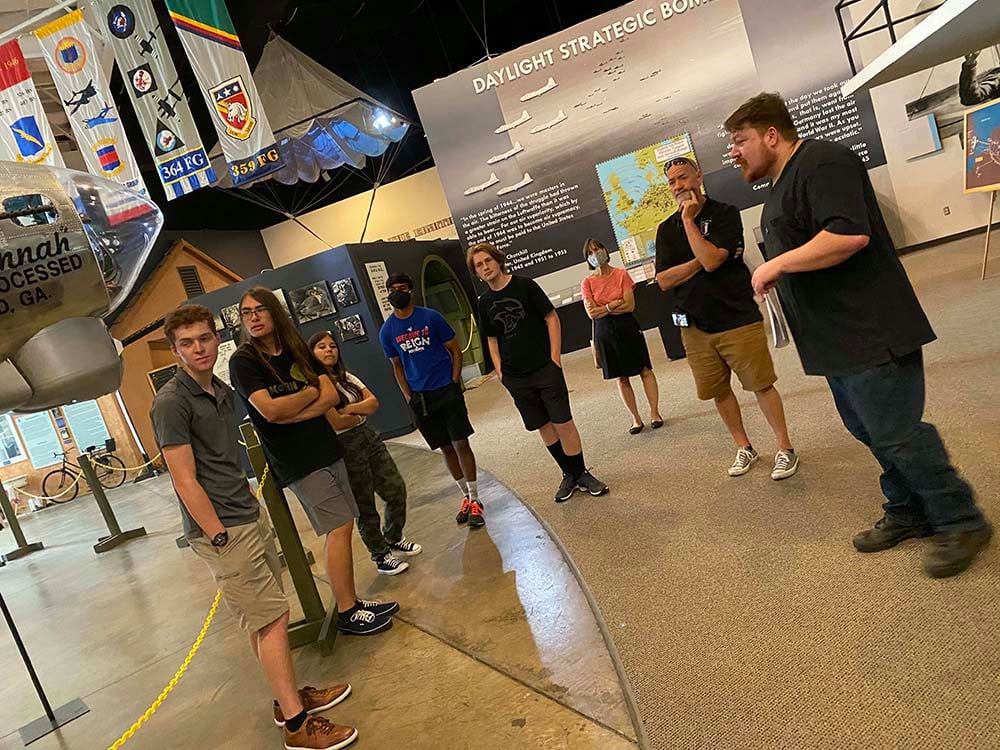
While I would have preferred to take the class through the B-17 myself, I was not going to step on anyone’s toes – it is their museum after all!
I did get to talk to the class later on in the day.
Photo taken 18 September 2021.
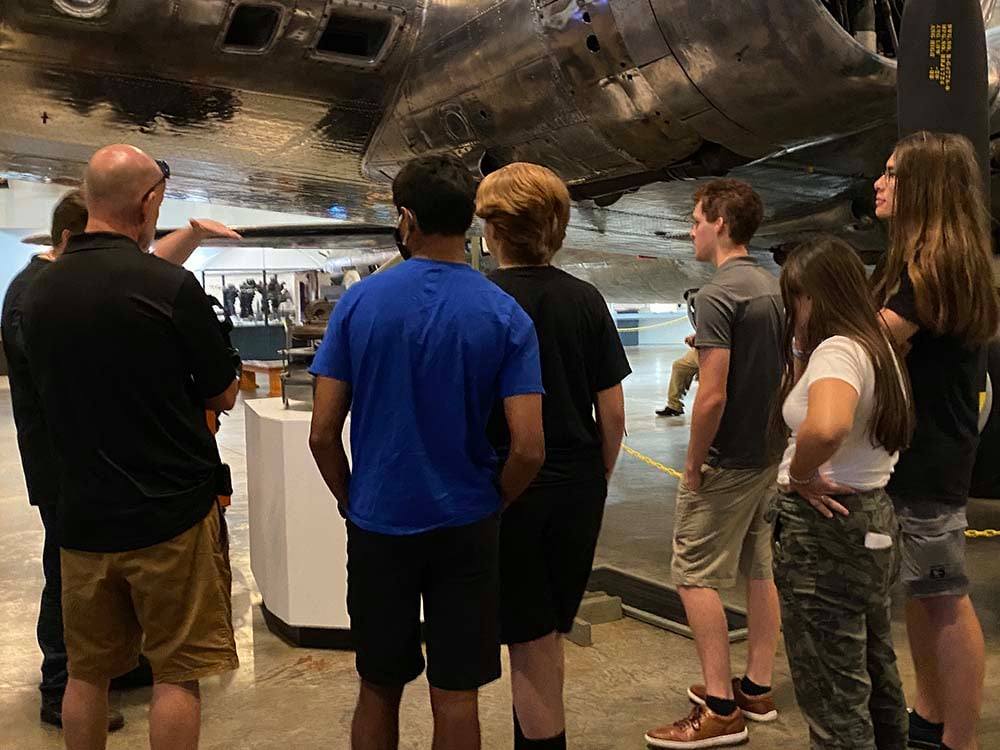
Explaining the turbocharger system on the Boeing B-17.
Photo taken 18 September 2021.

Outside the museum sits Boeing B-47 50-0062. Savannah was the site of a notable BROKEN ARROW incident in 1958 when a B-47 accidentally collided with a North American F-86. The bomber jettisoned its Mk. 15 nuclear weapon which, to this day, has yet to be located in the waters off nearby Tybee Island.
Here some of the students examine the tail, looking to see where the tail gun was originally installed.
Photo taken 18 September 2021.
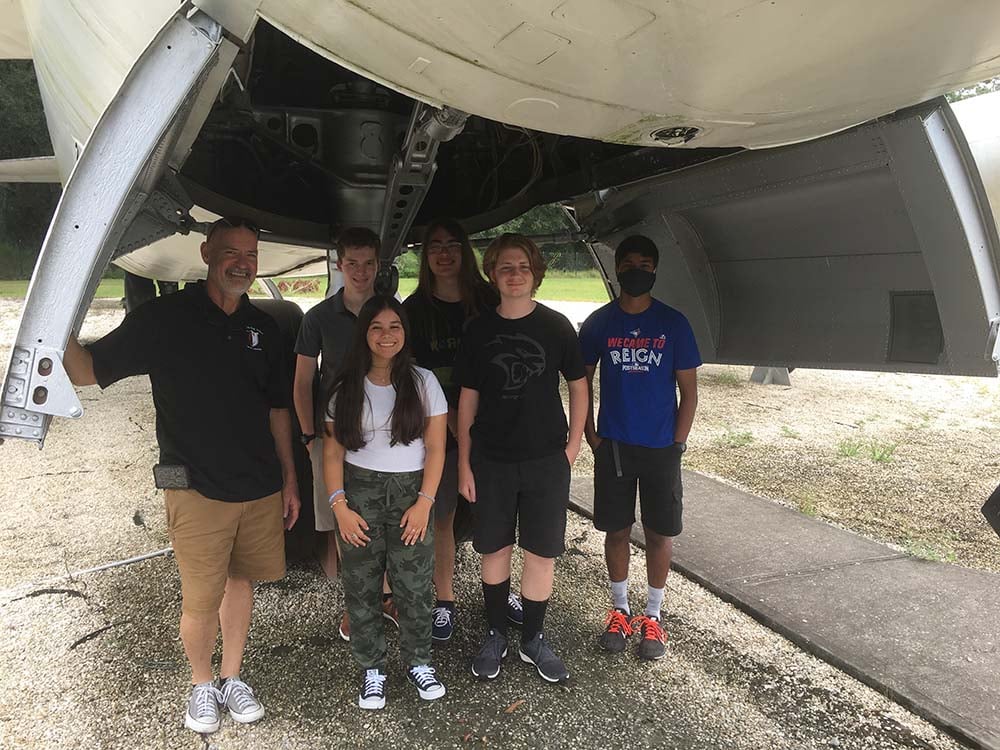
The students pose under the forward gear bay of the Boeing B-47.
Photo taken 18 September 2021.
This update covers a few topics.
First up, Chris Monroe from Desert Rat has done it again! He alerted us to a source for the B-17’s Type A-5 Dome Lights. These were the largest of the interior lights, with a total of seven being scattered throughout the aircraft. We were lucky to find an entire complement of them still in their original boxes. Thanks Chris!
Second, I am pleased to announce that we now have all the gauges necessary to fill the pilot’s side of the primary instrument panel. There are not too many spots left to fill out the panels, so if you wish to help by contributing the needed gauges, the missing ones are:
2x AN5795-6 Dual Temp. Gauges
2x C-12 Altimeters (the extra is for the Bombardier)
2x C-14A Dual Fuel Pressure Gauges
2x D-7 Airspeed Gauges (the extra is for the Bombardier)
1x D-8A Manifold Pressure Gauge
1x E-10 Tachometer
All of these should glow green when placed under a blacklight.
Naturally, this list doesn’t include the large number of dimmer lights (green & amber), A-1 oxygen flow indicators, and K-1 oxygen pressure gauges also needed.
For everyone’s enjoyment, also attached are some recent pics of Ray’s work skinning Liberty Belle’s aft fuselage.
Lastly, I want to make a point. The dome lights were part of a series of recent purchases made due to a generous donation from Shawn Knickerbocker (Clermont, Florida). Now, we at Hangar Thirteen have always tried to be open about where we need help. That is because we know how it feels to be constantly accosted for money. So, we try to tell you exactly what we need. It’s our way showing you where your money goes, as well as allowing you to purchase items for Lucky Thirteen yourself (if you so wish).
However, sometimes things pop up you do not expect, and if you don’t act right away, the opportunity is lost. When that happens, you do not always have time to reach out to your followers and/or start a fundraiser. I have seen it happen many times. As such, if you can spare a few bucks, it REALLY helps us to build up an emergency reserve for when opportunities like these dome lights come along.
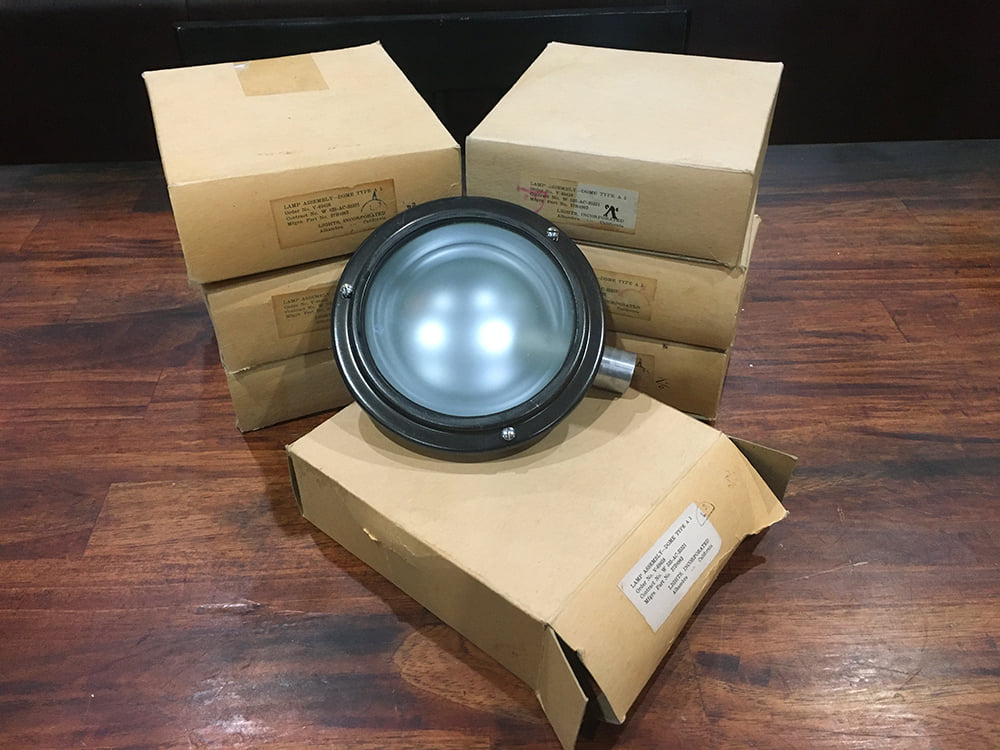
The newly arrived Type A-5 Dome Lights.
Photo taken 9 September 2021.

Looking up from the crawlway into the cockpit of an E-model B-17. Note the lack of an Emergency Hand Brake, characteristic of F-models. The cockpit’s dome light is mounted directly behind the Command Radio Receiver controls.
Though not visible, another dome light was mounted next to the photographer, illuminating the crawlway into the nose.

The A-5 Dome Light that illuminates the bomb bay catwalk. This step is beside Station 4 – the back wall of the cockpit.
The little dimple on top of the step is the connector for manually lowering/raising the bomb bay doors.
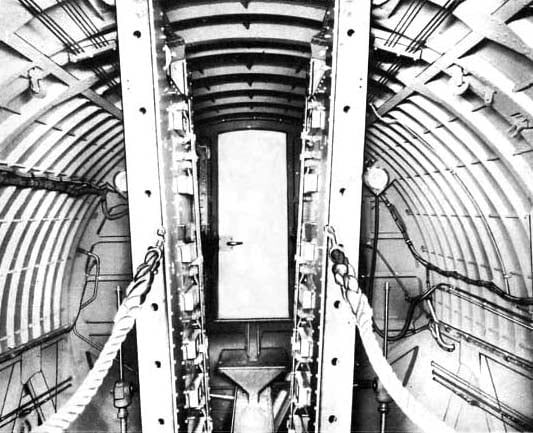
Looking back into the bomb bay, a pair of A-5 Dome Lights hang near Station 5 – the forward wall of the radio compartment.

The left side of our wooden instrument panel mockup. We will not move forward on the accurate phenolic panel and slotted screws until we have all the gauges we need.
There are also some minor issues to address. The Static Pressure Valve switch has a cover plate from an incorrect switch, so it will need to be replaced. Also, one of the three red jewel lights is missing its innards and cannot hold a bulb.
Photo taken 10 September 2021.

Lighting up the gauges on the left side with a small, blacklight. (It’s actually a cat toy.)
The bottom gauges are unusual in being fluorescent (orange) rather than phosphorescent (green). Surprisingly, this is not inaccurate – it appears this layout deliberately grouped the fluorescent gauges together.
Photo taken 9 September 2021.
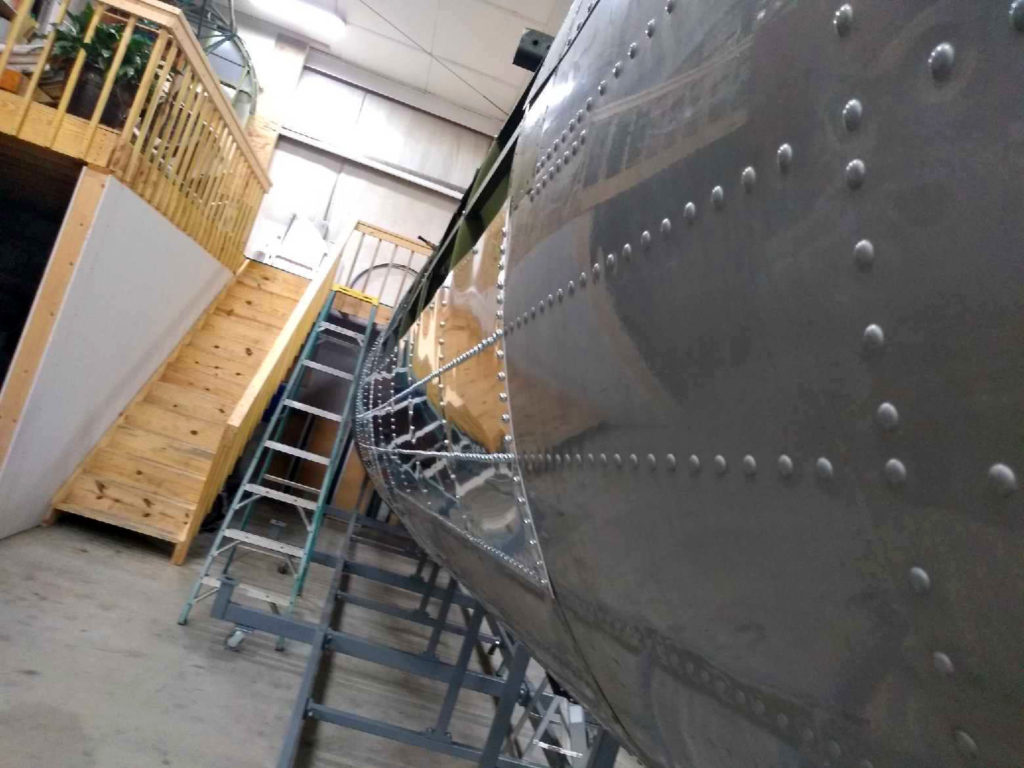
The left side of Liberty Belle‘s aft fuselage.
Photo taken 6 September 2021.
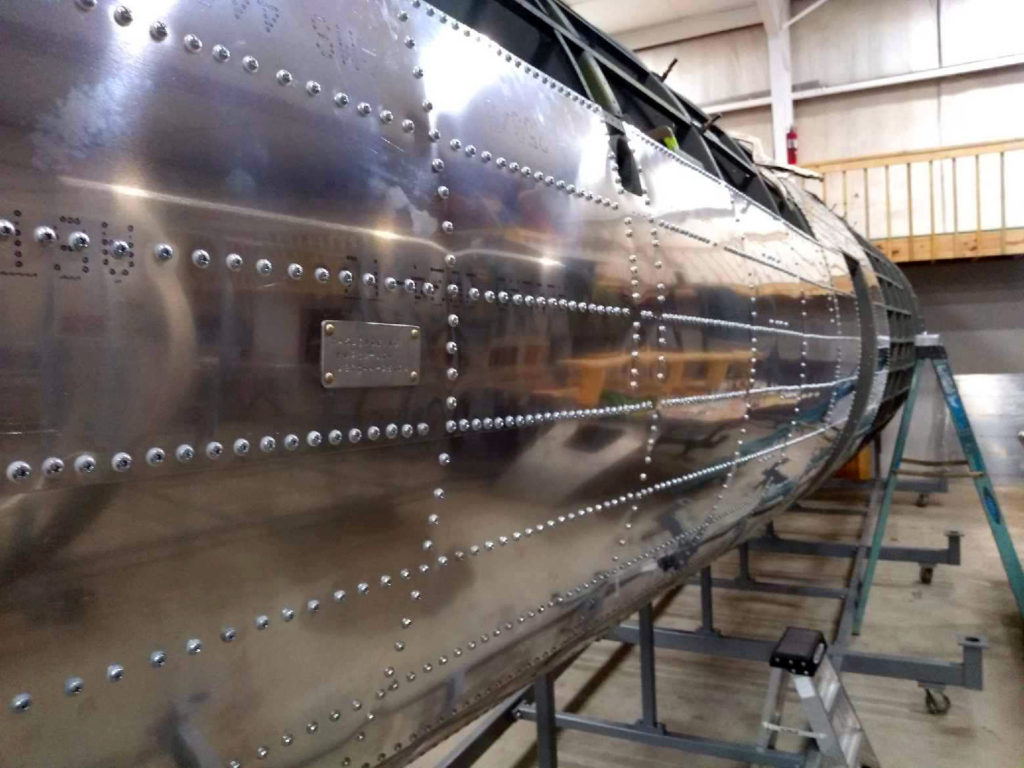
The right side of Liberty Belle‘s aft fuselage. The skins are held on with temporary screws so that alignment can be adjusted as Ray moves forward. Once everything is in place, then comes A LOT of riveting.
Photo taken 6 September 2021.
Some exciting new finds for this update.
First is one that we have been needing for a LONG time: a Type A-6 Bombardier’s Lamp. These are somewhat rare because they were typical of early-war aircraft. On E and F model B-17s, the A-6 Lamp was readily visible on the bombardier’s left side, right above the bomb bay door controls. Our friends at National Museum of the US Air Force took measurements and reference photos of the lamp from Memphis Belle, under the assumption that we would have to make a replica. But on the ride home from meeting Mr. Clint, I got a call from Chris Monroe from Desert Rat alerting me of one that he had found. I was so happy I pulled onto the curb! Thanks Chris!
The same source for the A-6 Bombardier’s Lamp also provided us with several examples of another type of A-6 lamp – the Type A-6 Cockpit Lamp. (Don’t you just love how inventive Army nomenclature can be?) For late-Fs such as Lucky Thirteen, there were seven A-6 Cockpit Lamps in total. Roughly the size of your thumb, these little lights were scattered about the airplane.
Another recent arrival was a Type A-11 clock, donated by Robert McHugh of Wantagh, New York. There were two of these aboard the B-17 – one above the pilots and one beside the bombardier. We were donated one by Steve Olson of Renton, Washington some months back, the clock originally belonging to his dad. So, this donation completes the bomber’s timepieces. The face of this clock was in beautiful condition (as the markings tend to fade) but the clock itself was nonfunctional. We sent it along to our friend Ed Fasanella who lovingly restored it to operating condition. Kudos to Robert and Ed!
Yet another arrival was a C-2 Rate-of-Climb Indicator, sent to us all the way from Croatia! Karlo Sučić was even kind enough to send a video of him flying with the gauge to show it in operation. Karlo did a fantastic job packing the gauge, wrapping it in heavy paper and covering the box in duct tape. Toonces the Cat loved that paper! Thanks Karlo! This is an important step toward completing the instrument panel, which is one of our current goals. You can track our progress and see what gauges we still need by visiting our website here.
Lastly, we recently acquired a Pilot’s Information File. This is the first step of a fun little idea we had – we thought it would be nice to place the appropriate Information File beside each crew position. After all, there are folders for them on board… To complete the collection, we need a copy of the Bombardier, Navigator, Radio Operator, and Gunner’s Information Files. The information in these files is incredible and some of them have been scanned over the years by various sources. You can see some scanned Information Files on the Library page of our website.

The newly arrived Type A-6 Bombardier’s Lamp.
These lamps were made by Faries Manufacturing of Decatur, Illinois. Faries lamps are highly sought after in the antique community for their rarity. The wartime contribution of this company is a little known footnote that we are proud to have an example of.
Photo taken 23 August 2021.
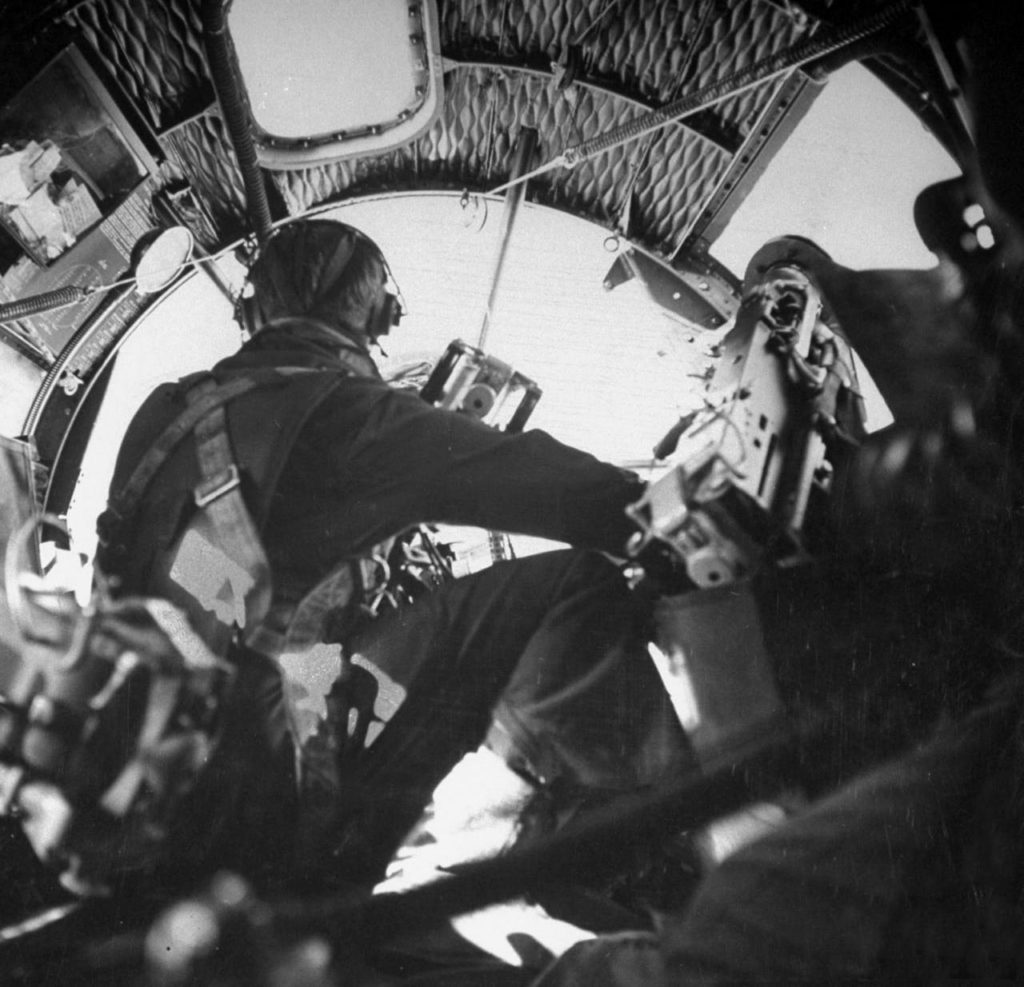
2LT Walter E. Witt in the nose of Winning Run (42-29944, 303BG) on 6 September 1943 – the strike on which Lucky Thirteen was shot down. Accompanying the crew this day was Life magazine photographer Frank Scherschel, who took this and several other high-quality photos. The A-6 Bombardier’s Lamp is visible to Witt’s left.
Winning Run ran out of fuel and bellied in shortly before landing.
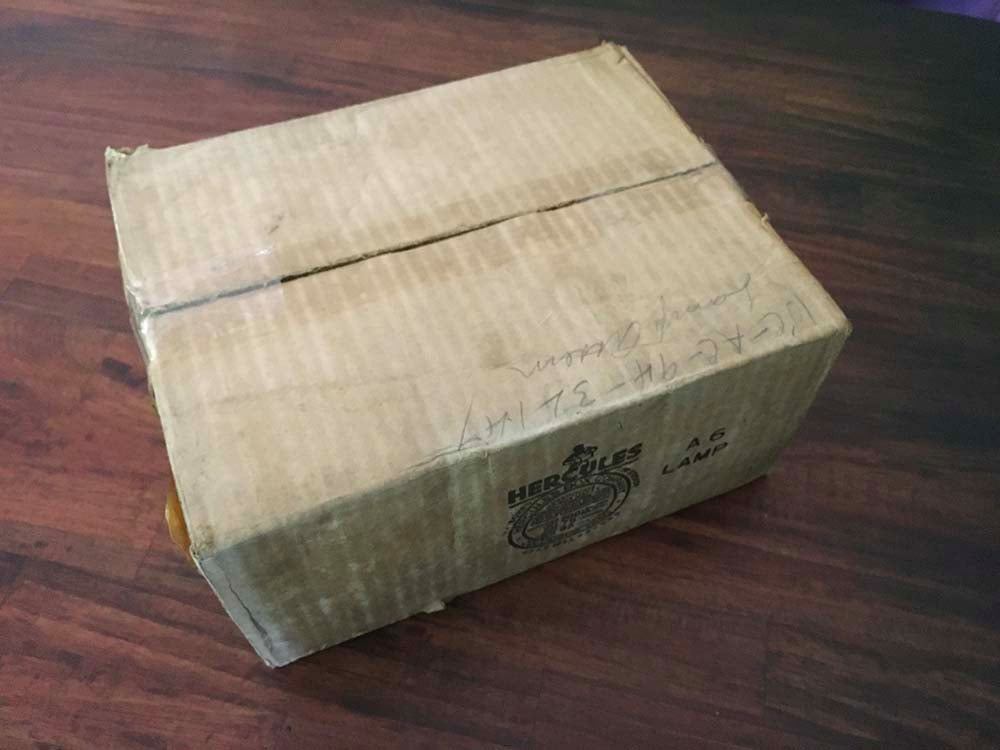
The Type A-6 Bombardier’s Lamp in its original packaging.
Photo taken 23 August 2021.
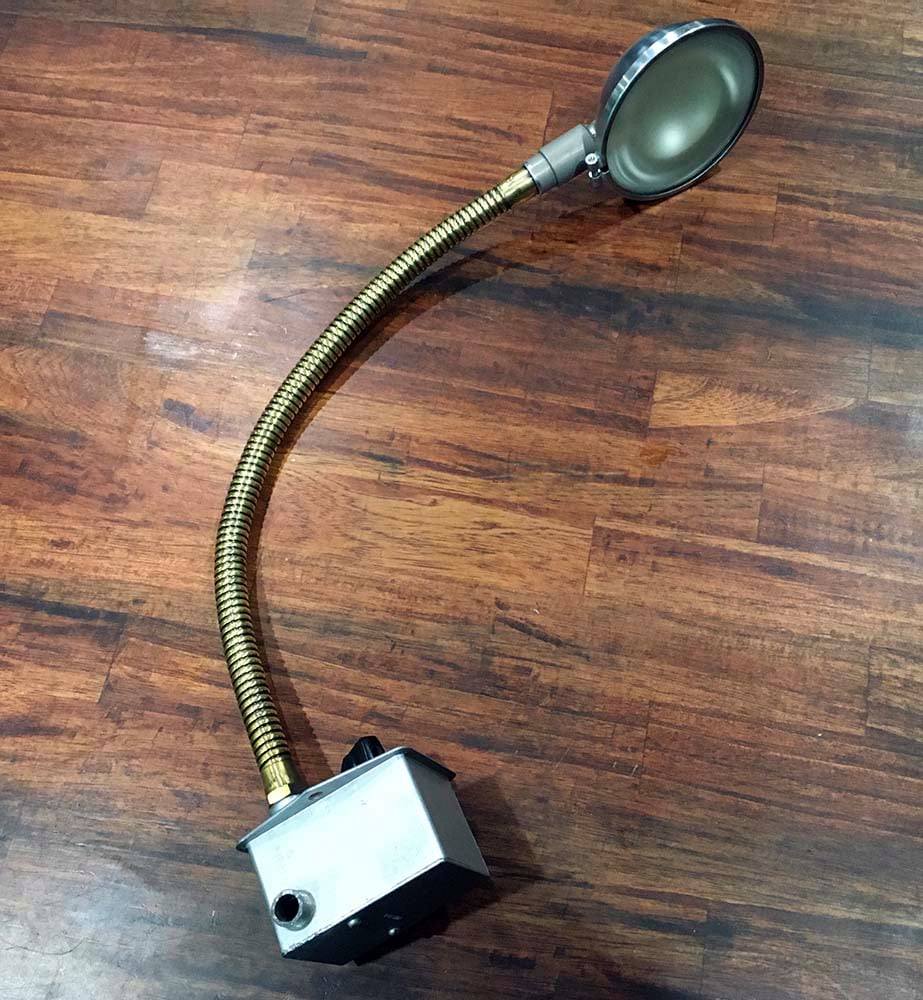
The newly arrived Type A-6 Bombardier’s Lamp.
The plug to which power is run is visible here.
Photo taken 23 August 2021.

The newly arrived Type A-6 Bombardier’s Lamp.
The silver bits are cadmium plated steel and the gooseneck is brass. The brass was slightly tarnished with age but was easily cleaned.
Photo taken 23 August 2021.
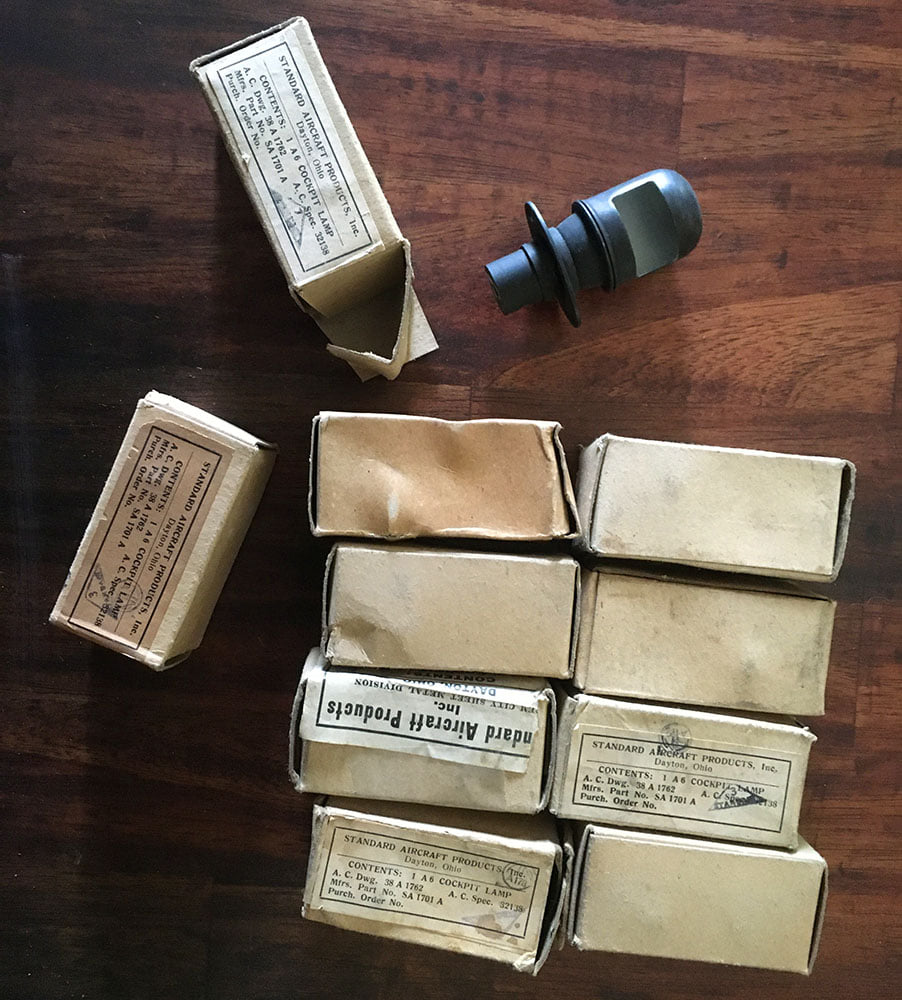
The newly arrived Type A-6 Cockpit Lamps.
Photo taken 14 August 2021.

The cockpit lights are highlighted in this closeup of a F-model B-17 cockpit.
The markings on the gauges were painted using phosphorescent or fluorescent paint, which glowed green or orange (respectively) when illuminated with a blacklight. Often, the paint was laced with radium so that the glow would remain even after the light was turned off.
We are fortunate to have a full complement of NOS C-5 blacklights.
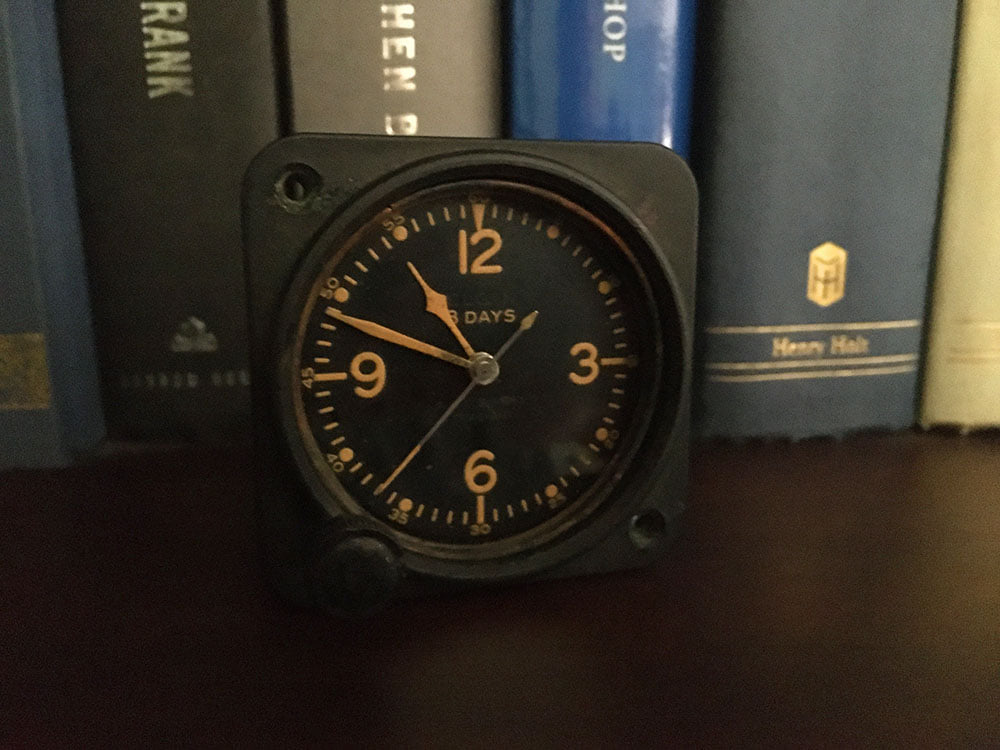
Robert McHugh’s newly-donated Type A-11 clock returns from the repair shop.
Photo taken 11 August 2021.

A manual illustration of an F-model B-17’s bombardier station.
This station is virtually identical to that aboard Lucky Thirteen.
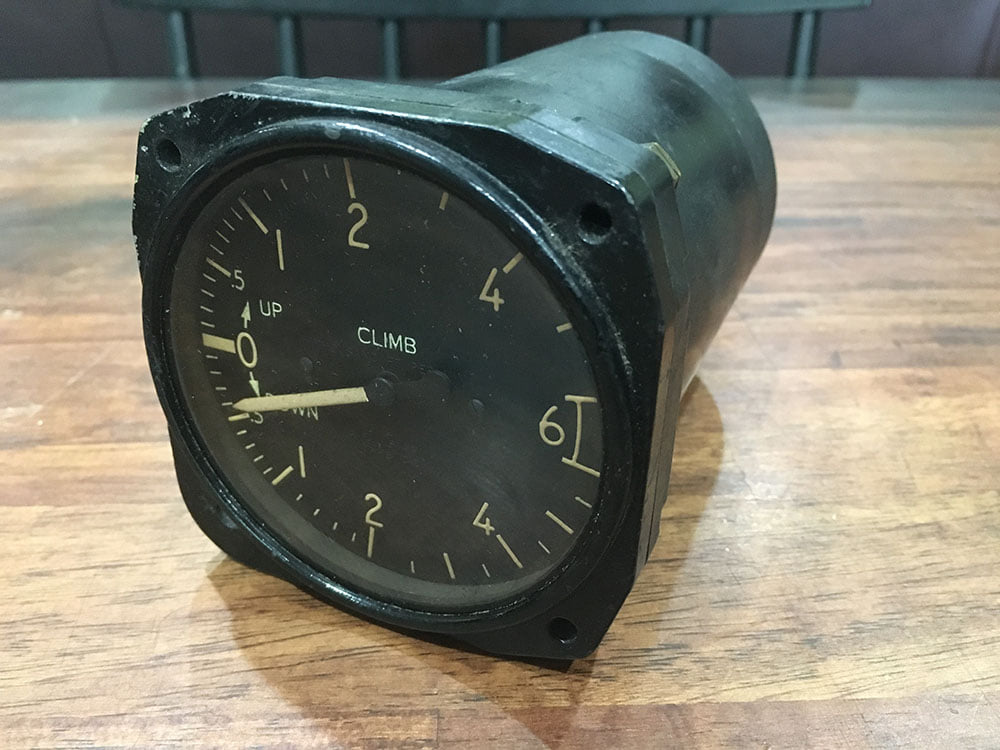
The recently arrived Rate-of-Climb Gauge.
Judging by the needle, it was shaken a bit in transit.
Photo taken 19 August 2021.
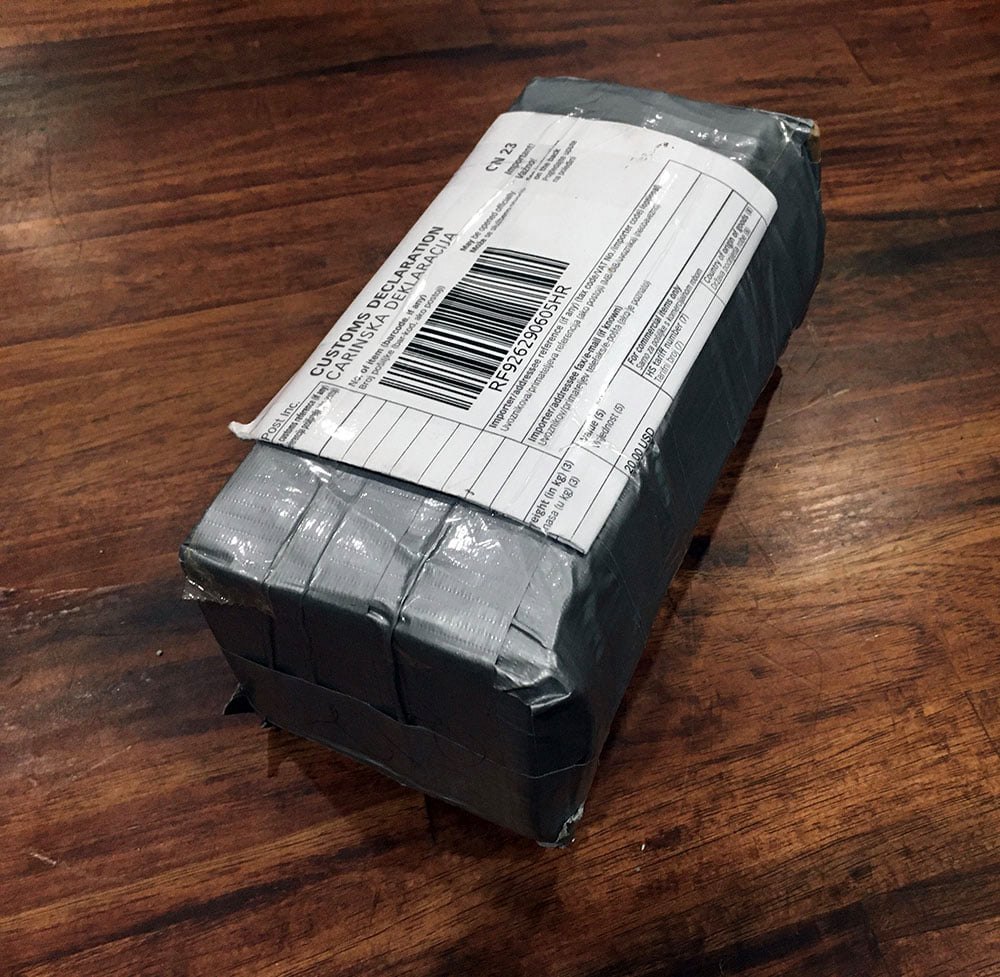
Karlo did a magnificent job packing the C-2 Rate of Climb Gauge.
Photo taken 19 August 2021.
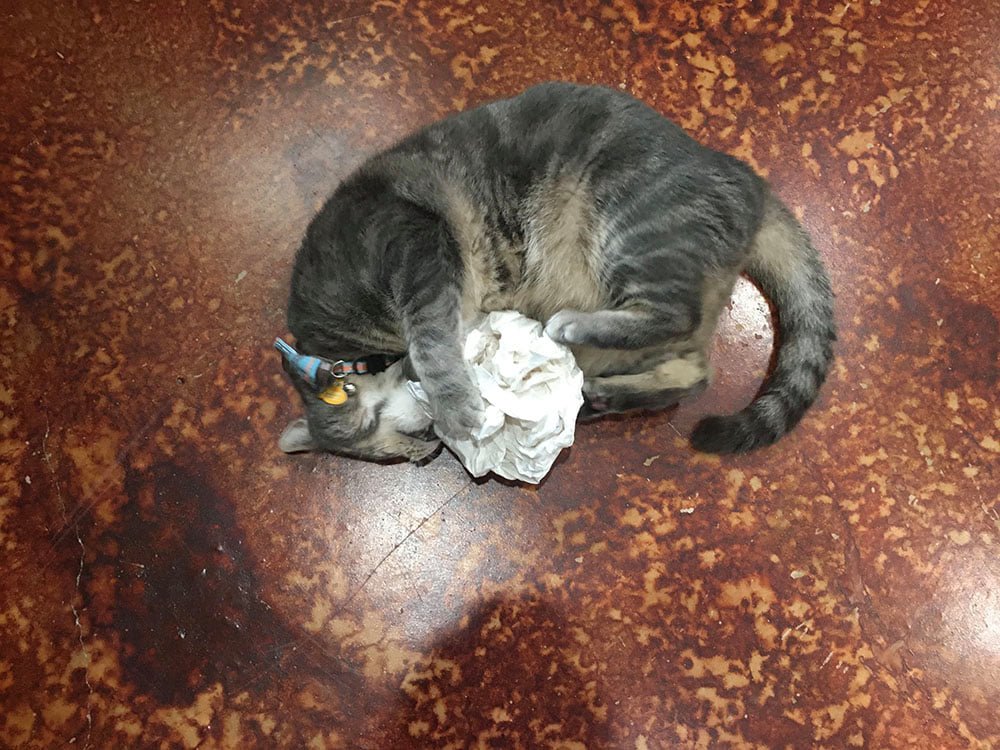
Toonces loved the paper Karlo used to pack the C-2 Rate-of-Climb Gauge.
He still has it.
Photo taken 19 August 2021.
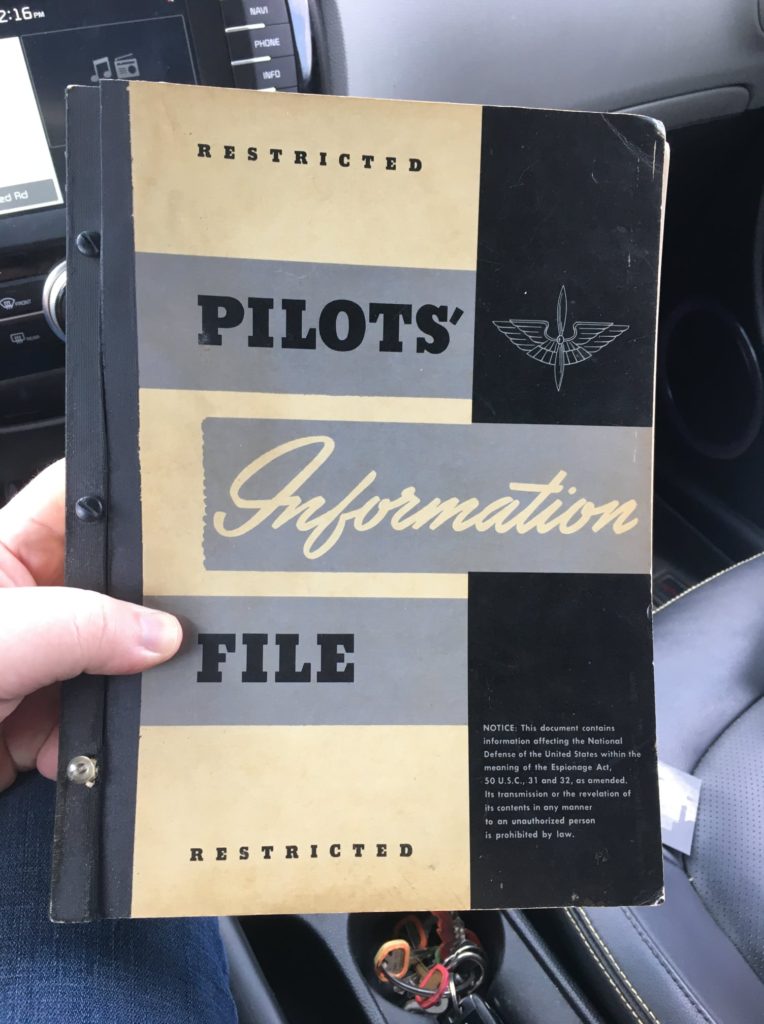
The first of hopefully several Information Files for Lucky Thirteen.
Photo taken 10 August 2021.
18 August was a fun day for us. We had some visitors scheduled to drop by, so I took the opportunity to bring up everything that came in recently from Belgium. Visiting was Shawn Knickerbocker, one of the EAA’s pilots for Aluminum Overcast, Stuart Smolkin from the Asheville Radio Museum, and Clint Gorman, a Second World War combat veteran.
TSGT Clint J. Gorman was a flight engineer/top turret gunner with the 367th Bomb Squadron, 306th Bomb Group, flying 29 combat missions throughout July to August 1944. Most of these sorties were made aboard Fightin’ Carbarn Hammerslaw (42-32099), which was lost on 5 December 1944. By chance, Clint was assigned to another aircraft that day, completing his tour-of-duty just days later. His comrades celebrated by tossing him in a mud puddle (in the freezing cold), and Clint was awarded the Air Medal on 13 December and rotated home.
At age 98, Clint is in remarkable shape, his hearing and cognitive abilities still in perfect order. Only his legs give trouble, which proved of little consequence – he would have stayed all day if he could have! Clint had a blast. It turned out that Clint became a radio enthusiast after the war and is a member of the Asheville Radio Museum. In fact, one of the command radio units we have originally came from him.
Because of his interest in radios, most of his time was spent going over the units already on display. (Wood prices are currently too expensive for us to finish putting the rest of our radios on display.) Regardless, Clint enjoyed examining the newly arrived top turret base, as well as the fuselage jigs for Lucky Thirteen, Liberty Belle, and some of Ray’s automotive side projects.
Special thanks to Clint, Stuart, and Shawn for visiting. It was an honor to host you and we hope you liked what you saw!
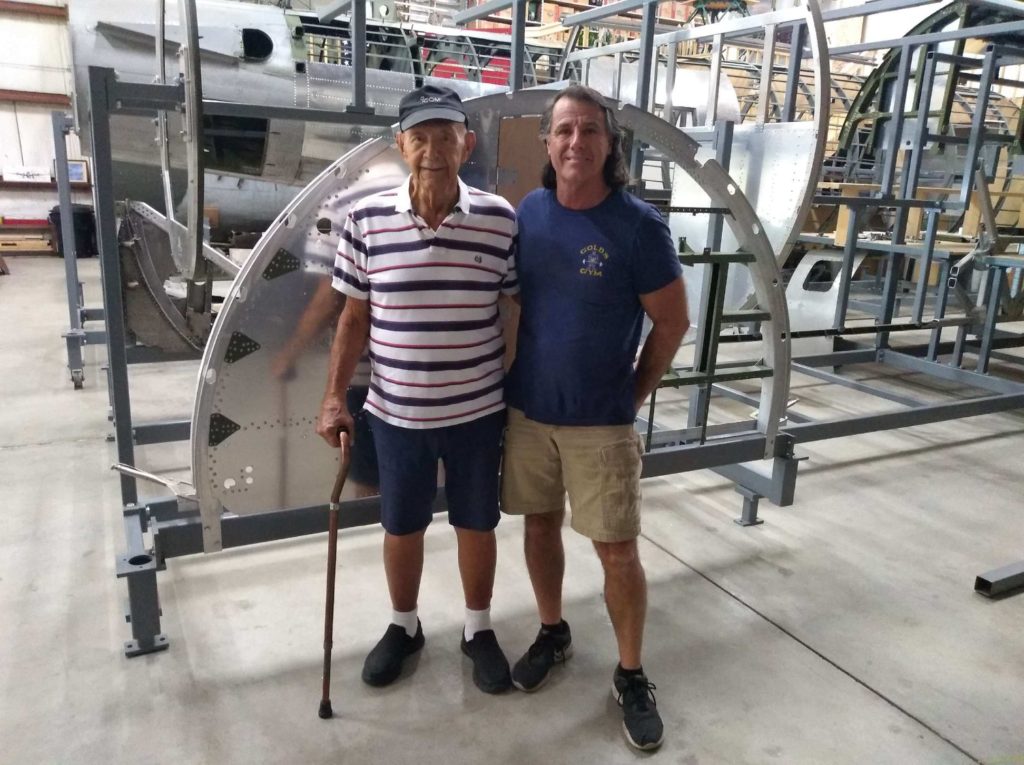
TSGT Clint J. Gorman poses with Ray in front of Station 5 to Lucky Thirteen.
Photo taken 18 August 2021.

Fightin’ Carbarn Hammerslaw (42-32099), the aircraft Clint spent most of his tour flying. The origin of the name is a mystery, as the aircraft was a transfer from the 457BG.
Fightin’ Carbarn Hammerslaw was lost on 5 December 1944 during a strike against the munitions dumps of Berlin, Germany. The weather was cloudy and all participating groups dropped via radar. Fightin’ Carbarn Hammerslaw dropped out of formation and was last heard calling a fix for Air-Sea Rescue. There were no survivors.
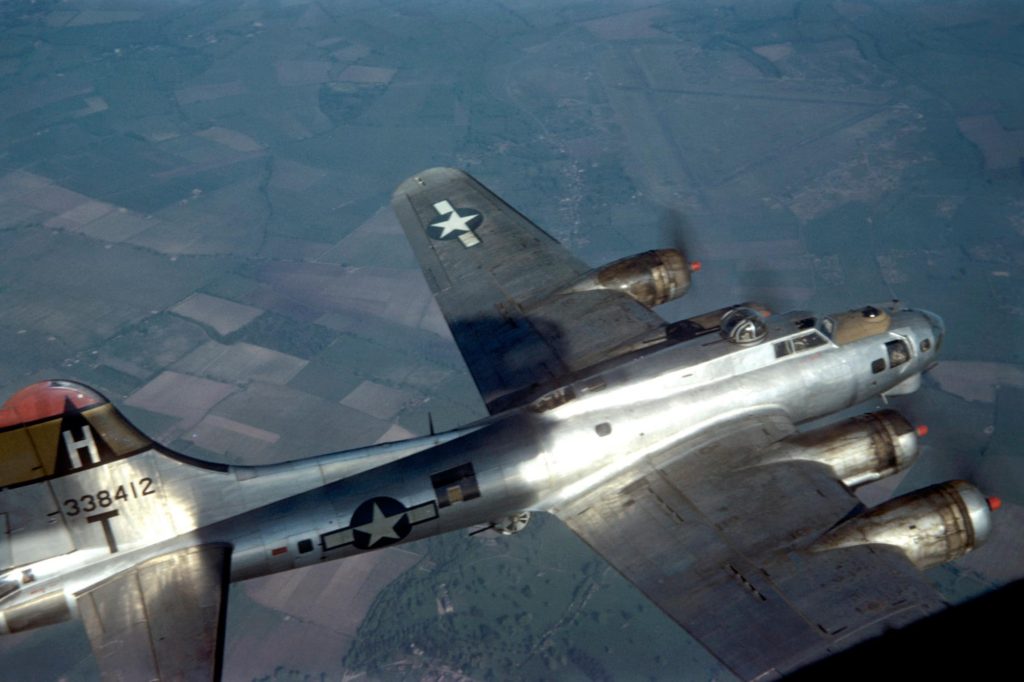
“T-Tare” (43-38412), the aircraft Clint was flying aboard on the day Fightin’ Carbarn Hammerslaw was lost. “T-Tare” survived the war and was scrapped in Kingsman, Arizona.
The strike of 5 December 1944 saw 451 Boeing B-17s strike the munitions dumps of Berlin, while 138 Consolidated B-24s bombed the railyards of Munster and 5 B-17s were launched on an APHRODITE drone strike. The bombers were escorted by 103 Republic P-47s and 798 North American P-51s. 12 bombers and 17 fighters were lost. German records note losing 94 interceptors this day.
Note the lack of flexible gunner positions on this aircraft. This photo was taken late in the war (circa spring 1945) when the threat from Luftwaffe interceptors was nil and these extra guns were no longer necessary.
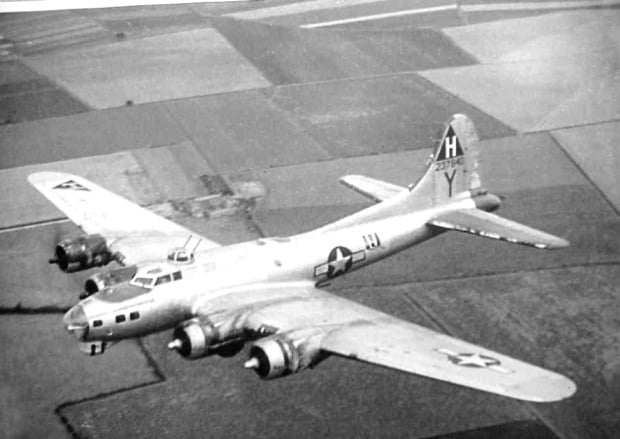
Combined Operations (42-37840), the bomber on which Clint flew his final combat mission on 9 December 1944. Clint’s final mission saw 413 Boeing B-17s, escorted by 36 Republic P-47s and 238 North American P-51s, strike the airfields and railyards around Stuttgart, Germany. 1 US bomber was lost.
This is the same target that Lucky Thirteen was lost on 461 days prior.
Combined Operations was lost on 15 April 1945 when it crashed on a practice flight over Pearlwick Bay due to fog. Alongside a crew six, the squadron executive officer, operations officer, a Red Cross nurse, and two others were also aboard. There were no survivors.
Some recent pics from the hangar:
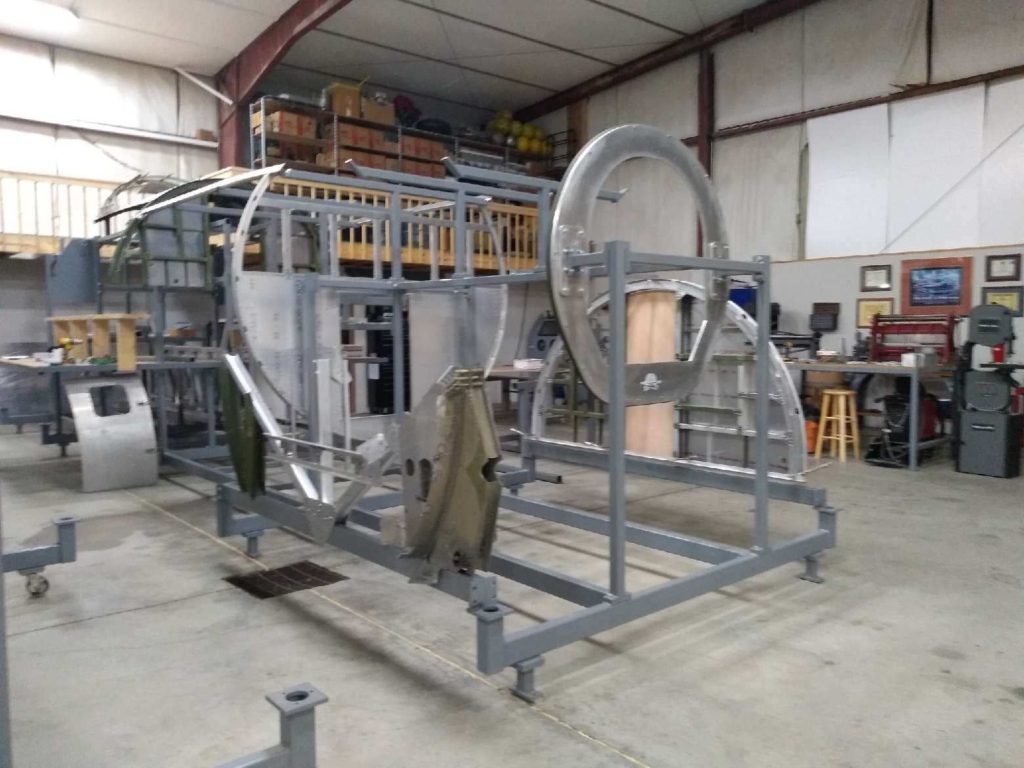
The carry-thru for Station 4 is clamped close to the floor to make it easier to work on. The carry-thrus form the backbone of the airplane and are a critical stage – even it is not the most noticeable.
It is coming along nicely.
Photo taken 4 August 2021.
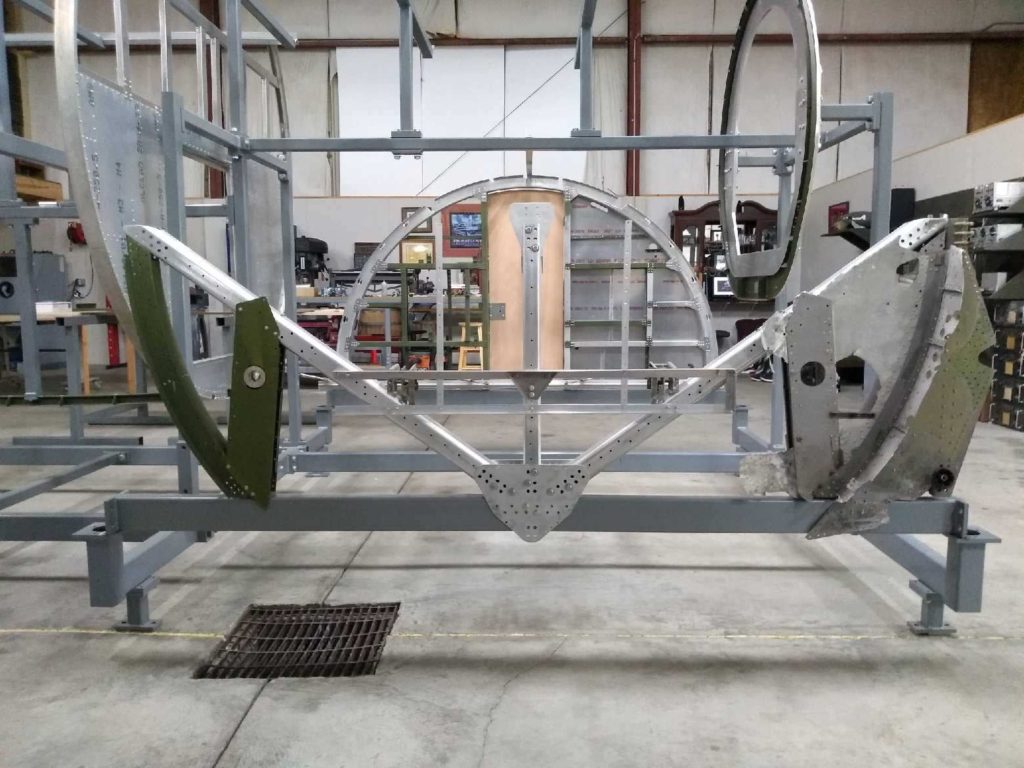
Restored versus original on the Station 4 carry-thru.
Photo taken 4 August 2021.
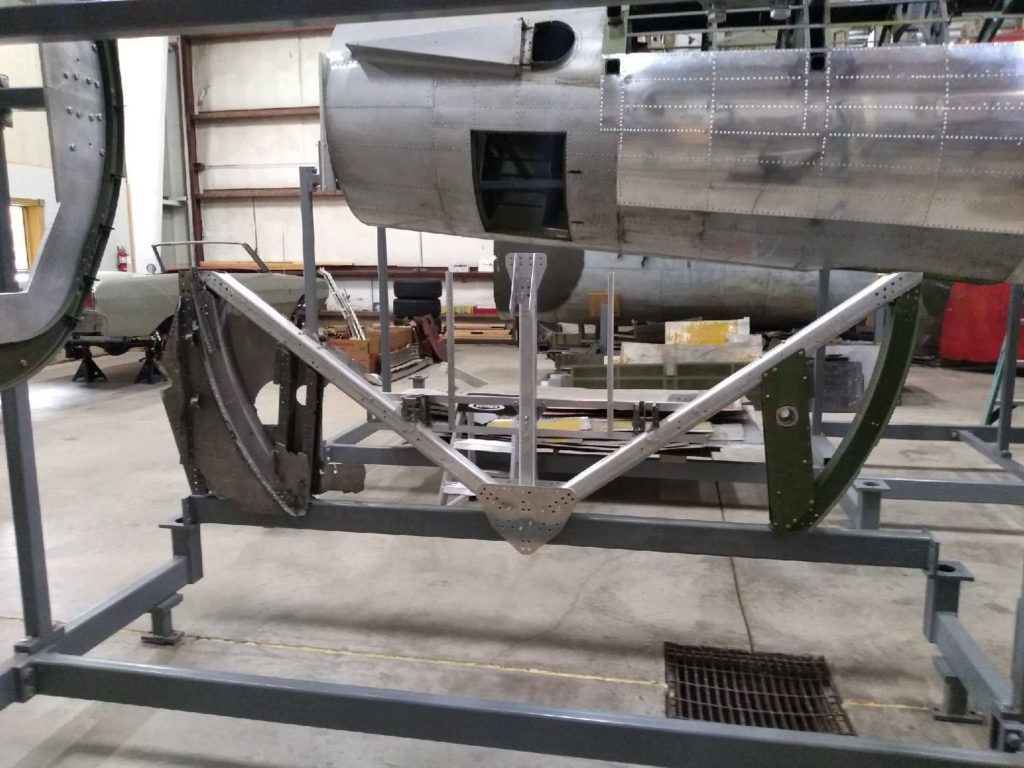
Restored versus original on the Station 4 carry-thru.
The aft fuselage of Liberty Belle is in the background.
Photo taken 4 August 2021.
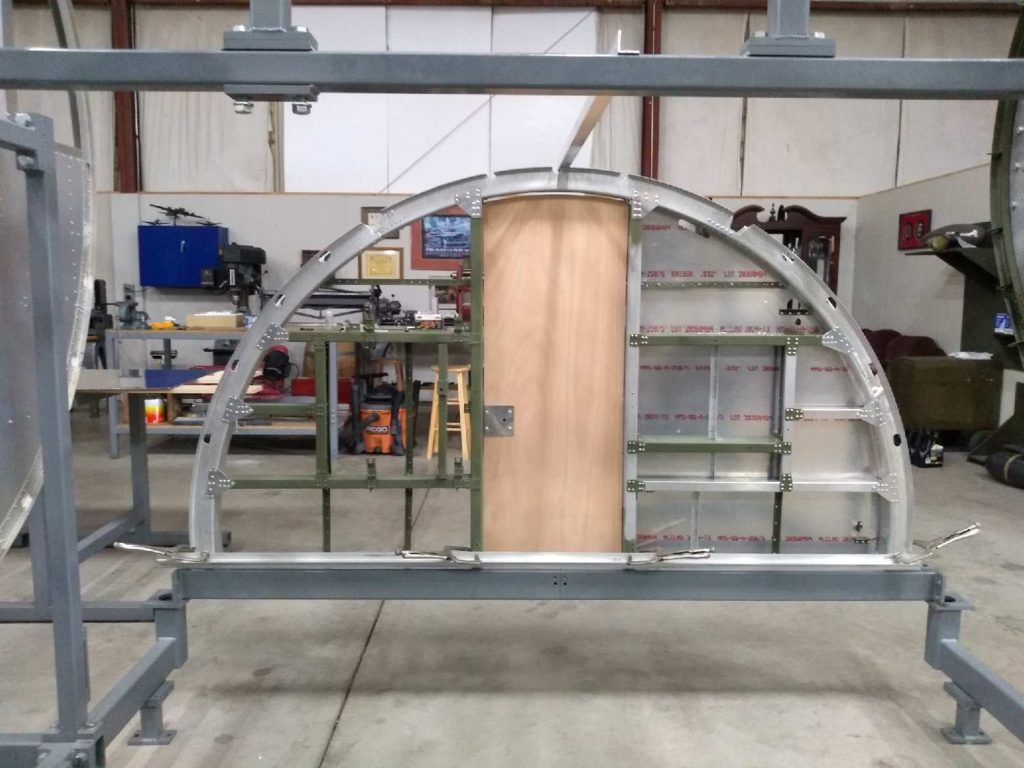
The green skin has been taken off to use as a pattern for the new, accurate silver skin.
These skins (from Station 5) are almost ready to have their period ALCLAD markings reapplied.
Photo taken 4 August 2021.
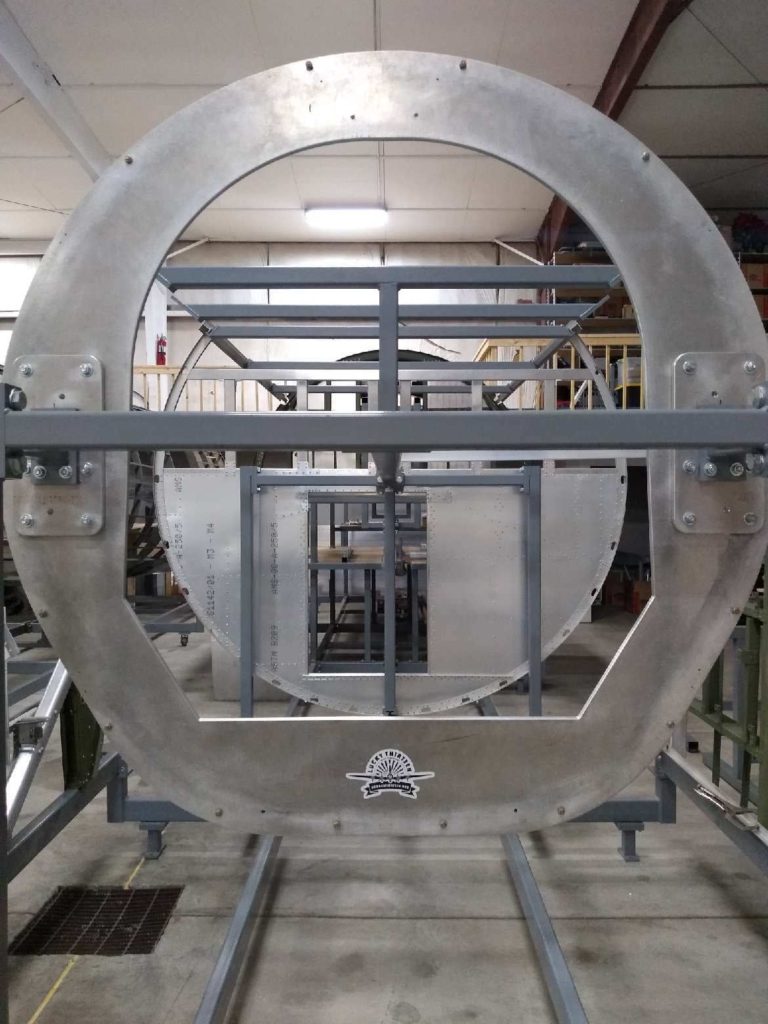
Looks like Ray found a good spot for a Hangar Thirteen car vinyl – on the jig support for Station 1 (the nose cone).
Station 1 itself is on the other side of the jig support. Station 3 is in the background, with the crawlway into the nose visible.
Photo taken 4 August 2021.
I thought I might talk about our progress on Lucky Thirteen’s instrument panel.
Some of you may recall how we cut a wooden mockup of the instrument panel some months back. The instrument panel was mounted in Station 3 of the B-17, and as such, had a unique curvature to it. This was replicated by laying out the panel on the computer and cutting it via CNC machine. The idea was that we would mount gauges into the wooden mockup as we found them – that way, if any adjustments needed to be made, we could make them before doing the final product.
The final panel will be cut from phenolic, as per wartime spec. Phenolic was a sort of wartime plastic made using resin-based polymers (Micarta and Bakelite are both forms of phenolic). Bob Hachmann is currently working on the box frame for the panel, which is unique from most panels as the B-17F frame was aluminum (as opposed to the plywood frame on the B-17G). When Bob finishes the frame, the phenolic faces will be cut.
So far, we have made excellent progress in locating the correct gauges. We recently uploaded a new instrument list to our Instruments page, which lists the manufacturer part numbers to all gauges accurate to Lucky Thirteen’s panel. If you can help complete the missing gauges – either by donating from your personal collection or purchasing pieces online – please do so. They will definitely go to a worthy home!
On a related note, we were recently honored to receive volunteer help from Anton Hermans . Anton holds the distinction of being the volunteer from farther away – he lives in Thailand! Anton fabricated a new center console plate for Lucky Thirteen. This is the panel which holds the bomber’s magneto switches, fuel booster pump switches, running light controls, landing gear switch, and cowl flap controls. Anton is now moving forward in recreating the box assembly that fit under this panel (which is far more complex than people realize). He is being helped by our friend Rian Olsen, who is also helping with Lucky Thirteen’s panels.
Lastly, we received an amazing donation from Sparky Sparks of Arizona, contributing a beautiful Type B-14 seatbelt. The B-17 carried a total of six seatbelts, outfitting the bombardier, navigator, radio operator, tail gunner, and pilots’ positions. The waist gunners were each equipped with a Type A-3 belt, which wrapped through their parachute harness, and the turret gunners with Type A-4, which served as a sort of lean-to. If you have a Type B-11/B-13/B-14 seatbelt, or a Type A-3 belt strap or Type A-4 lean-to, and would like to contribute them to Lucky Thirteen, please let us know! Thanks to Sparky for his amazing contribution!
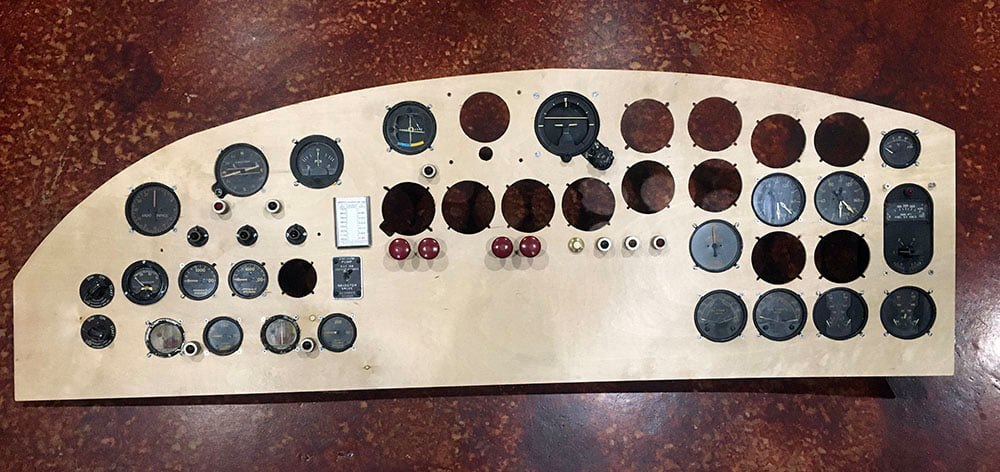
The wooden instrument panel mockup sits on my living room floor.
One of the three red jewel lights is missing its guts and will have to be replaced if it is to function.
The “Suction Gauge” switch is in reality a “Static Pressure” switch. We found a few of these NOS but they lack the correct faceplate. If anyone has an original, we can replicate the correct plate with the aid of an original scan.
Also notice the A-1 Oxygen Flow Indicator and K-1 Oxygen Pressure Gauges – we will need a lot of these…
Photo taken 4 August 2021.
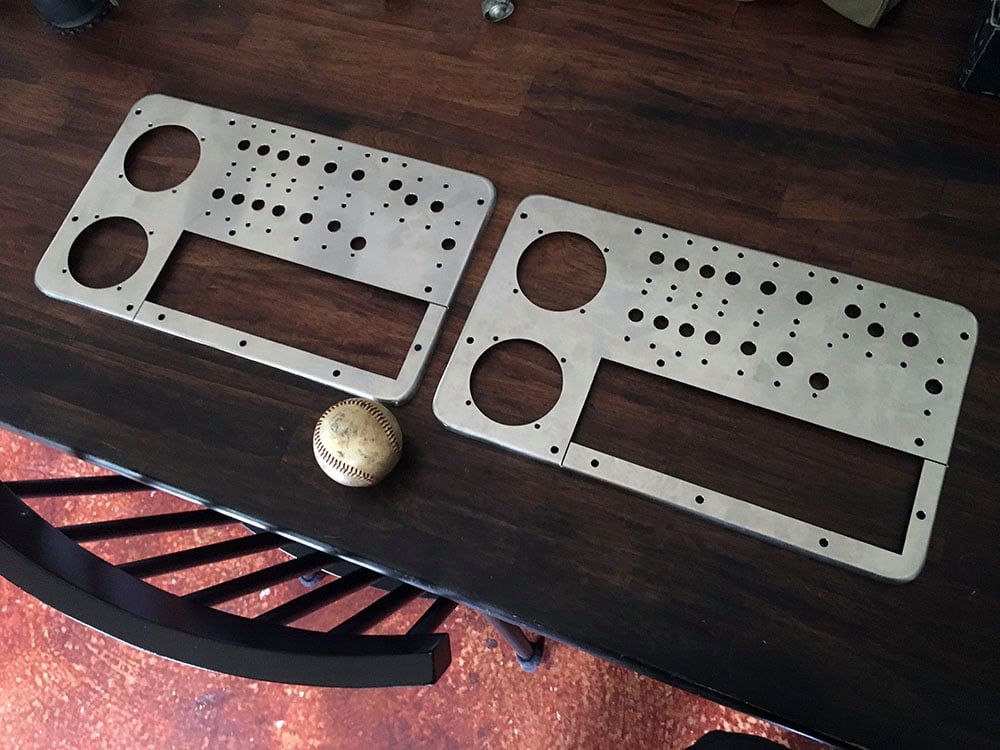
The newly arrived Center Console Panels made by Anton Hermans. Anton was kind enough to make a pair, for safety’s sake.
The baseball is for size comparison.
The large rectangular hole is for the Cowl Flaps Panel.
Photo taken 19 July 2021.

The original B-17 magneto switches purchased from Robert Oman of Lake Geneva, Wisconsin are placed into Anton’s newly contributed panel. Robert’s switches are confirmed as coming from a B-17 due to their unique markings.
Perfect fit.
The unusual piece on bottom left is a keying switch for the aircraft’s running lights. This was purchased from Don Keller, who is one of our biggest supporters.
Photo taken 19 July 2021.

A wartime photo of an F-model B-17 cockpit. Based on the layout of the gauges, this aircraft is older than Lucky Thirteen.
Note the bar assembly connecting the two magneto switches. This will have to be replicated.
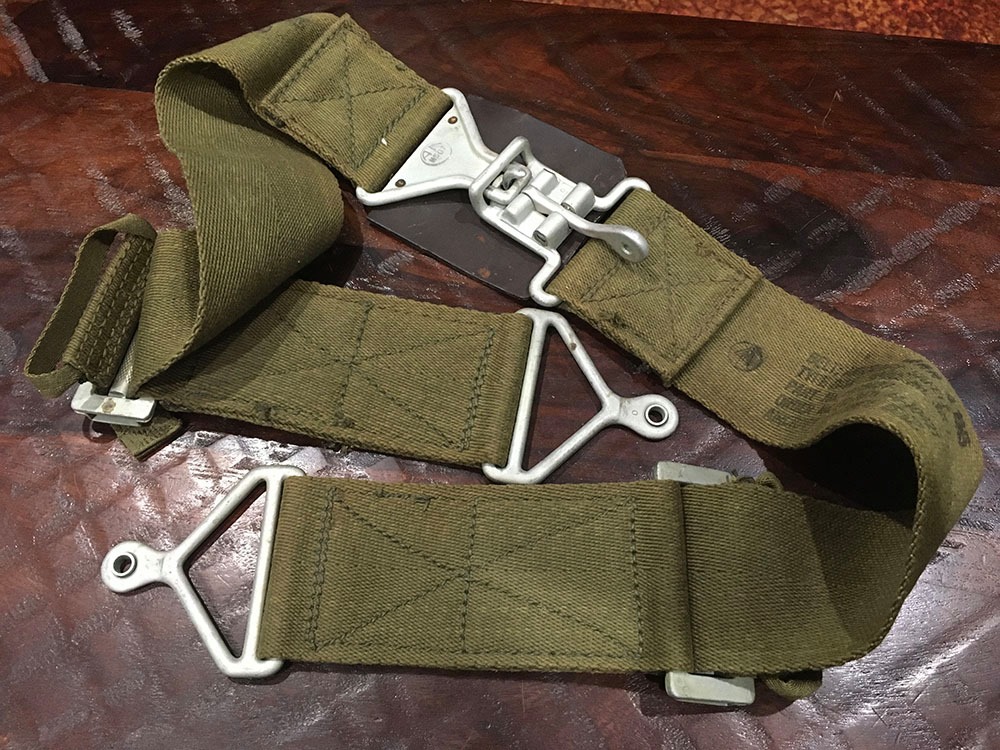
Sparky’s newly-donated seatbelt. I have never seen one so pristine – thanks Sparky!
One down, five to go!
Photo taken 2 July 2021.
Special thanks to the 384th Bomb Group for featuring Hangar Thirteen on the front page of their June 2021 newsletter! The article briefly touched on our plans to fundraise the rebuilding of top and ball turrets for Lucky Thirteen. On this subject, we have some news:
With the recent arrival of the crate from Belgium, a trip was in order down to Fred Bieser’s place to deliver parts from the Belgian Aviation Preservation Association and trade those turret parts that were too late-war for Lucky Thirteen. Out of this trip, we were able acquire a Type A-2 fuse box for the ball turret (exchanging our Type A-2A) as well as a pair of charging handles for the ball turret’s AN-M2 .50 caliber machine guns.
Speaking of armament…
A recent acquisition since our last post was an original E-10 recoil unit, also known as an “Edgewater” adapter. This is the third located for Lucky Thirteen so far, who will ultimately need seven in total. The Edgewater was traded with a collector who offered to exchange real Edgewaters for aluminum replicas. This is the first Edgewater to come from that trade, with Bob Jacoby doing a superb job – even going so far as to match the original threading!
Speaking of Bobs…
In response to our recent post on the waist and nose/cheek gun ammo boxes, we were asked to create a set of late-war ammo chute clips for a certain B-17G out west. Bob Hachmann beautifully completed this request, making fourteen in total.
As for myself…
This summer in South Carolina has been far more humid than usual, which has slowed me down from my work sorting through the McKowen Collection (yes, that’s still going on). Still, one recent bit of excitement… I found a Type Q-1A heating rheostat. Just need a dozen more to go!
Occasional rains have brought some relief and during that time I have also done graphic design work, recreating original charts and placards. The most recent ones have been a Calibration Card for the TU-5B Tuning Unit, a Compass Correction Card, an Airspeed Calibration Card, and an Altitude Correction Card. These latter three were originally held in purpose-built card holders. Also held in a holder was the Temperature Correction Card, though a reference has not been located yet for this card.
Lastly, we also recently acquired a set of NOS brake valves. These valves were mounted by the rudder pedals, being one the few systems on the B-17 that was hydraulic rather than electric. Sadly, we have not been able to locate the type of valves used on the other brake: the Emergency Hand Brake. Its valves will likely have to be recreated.
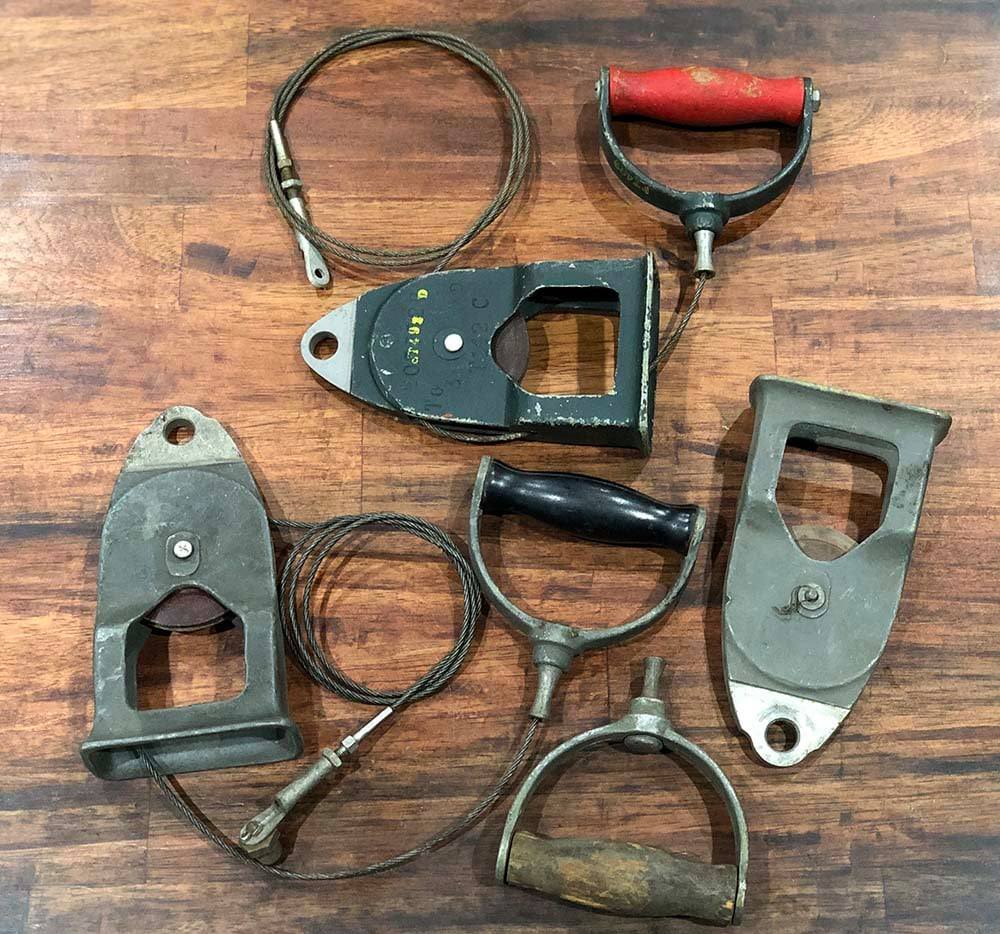
The new gun charging handles for the ball turret.
Since we intend for the ball turret to be a Briggs rather than an Emerson, we are focusing on gray-painted parts. As such, we are to move the hardware from the green handle (top) and move it to the gray assembly (bottom right), returning the unused portion.
Seeing as the wood is quite old and brittle, we will also look into creating new handles.
Photo taken 14 July 2021.
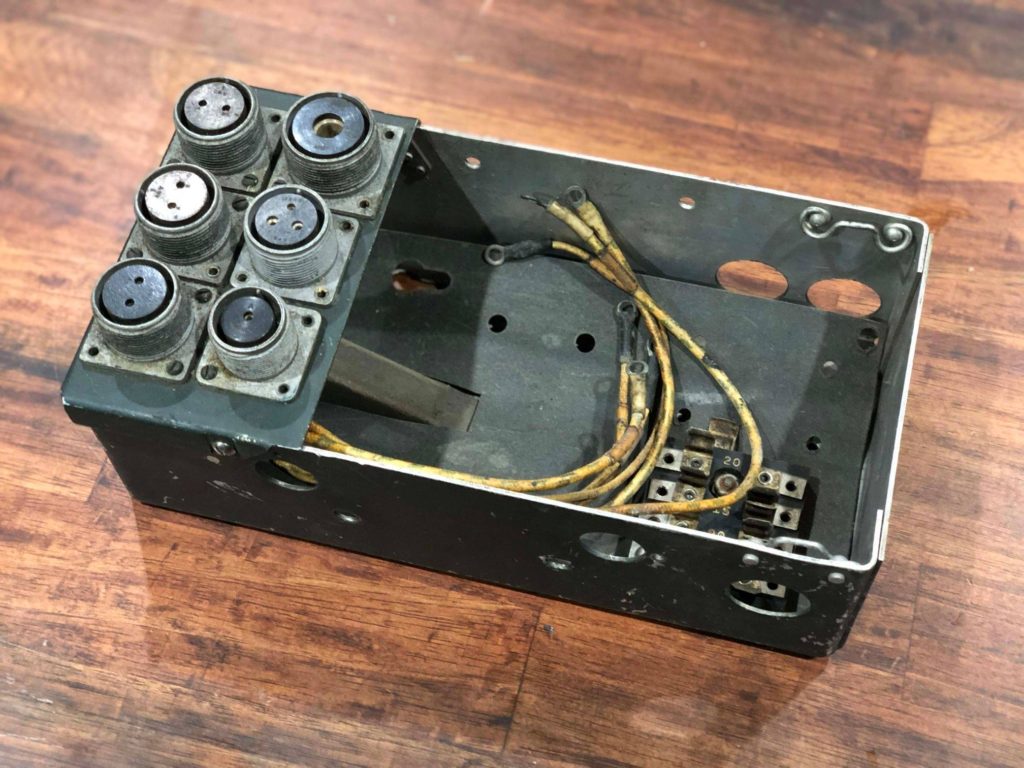
The Type A-2 ball turret switch box. The main difference between this switch box and the one from “K-King” (which was an A-2A) is the location of the cannon plugs. On the latter box, the plugs were on the bottom.
One minor note here:
The old adage that Briggs turrets had gray interiors and Emersons had green interiors was turned upside down with this piece. It has a Briggs serial number…
Photo taken 14 July 2021.
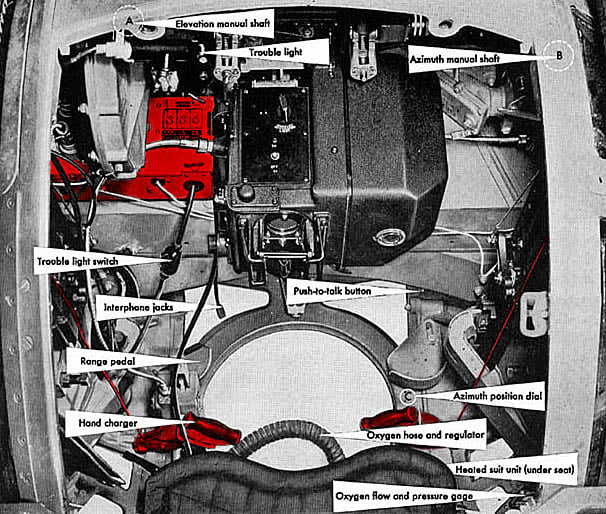
The switch box and charging handles are highlighted in this manual photo of a Briggs-built ball turret.
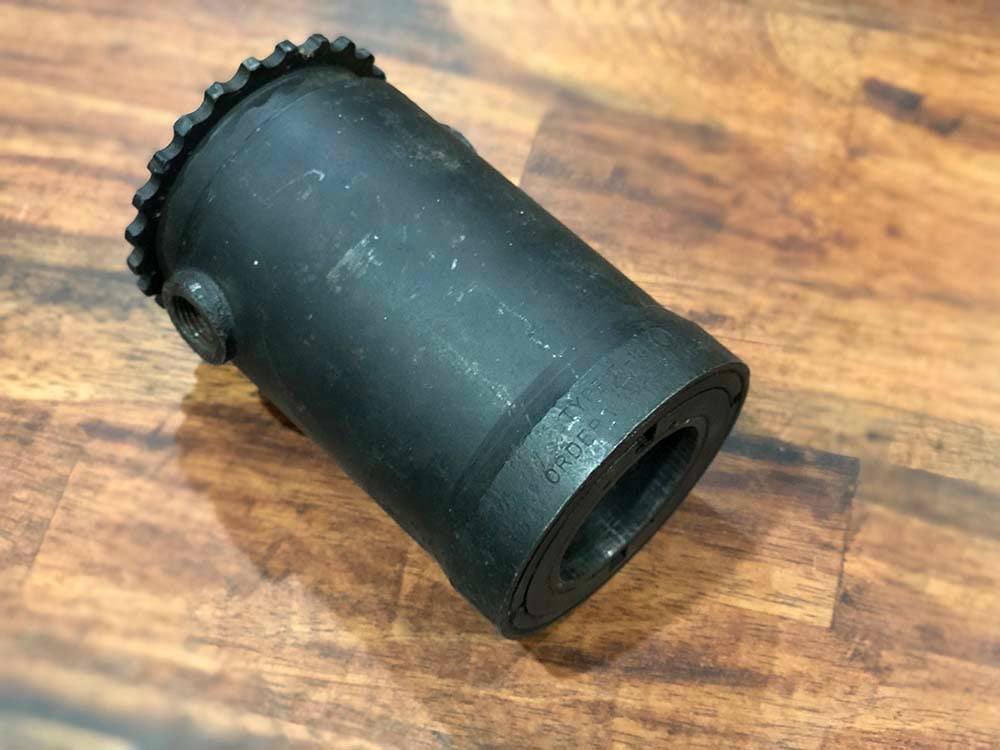
The third Edgewater adapter located for Lucky Thirteen – four more to go. This one is special in that it is clearly dated as being manufactured in 1943 – the same year Lucky Thirteen rolled off the line.
Photo taken 14 July 2021.
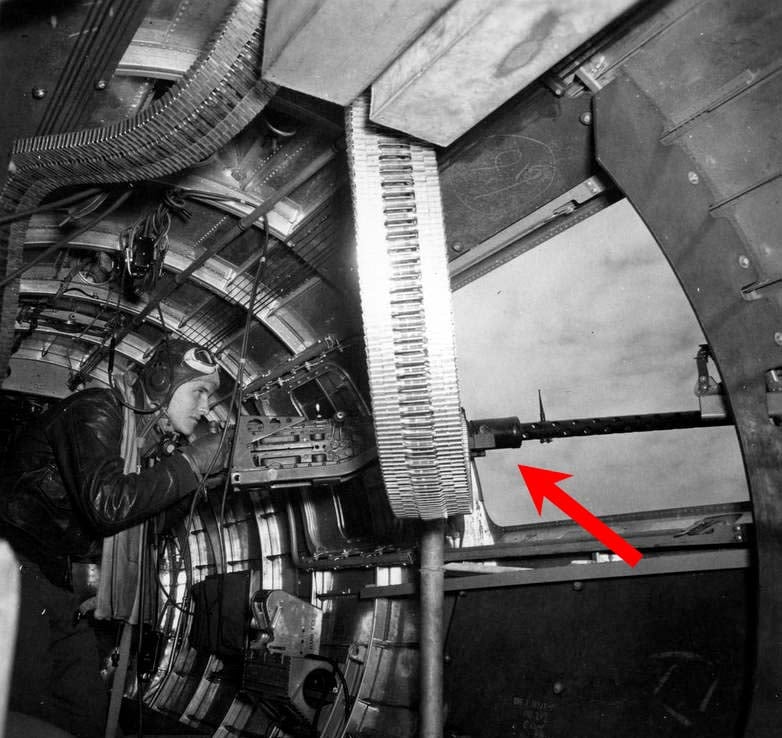
The right waist gunner on Hell’s Angels (41-24577, 303BG) poses at his position.
The E-12 gun cradle, which holds his AN-M2 .50 caliber MG, attaches to bolts on the sides of the Edgewater. The Edgewater is attached to the gun, wrapping around the cooling jacket. The Edgewater absorbs recoil by spring action, and was commonly found on gun positions exposed to the open air.
Hell’s Angels has the distinction of being the first Boeing B-17F in the US 8AF to complete her combat tour of duty. Being an early-F, her waist guns were originally can fed, but were altered to use boxes mounted to the ceiling. An original ammo can, however, can still be seen here stowed against the wall.
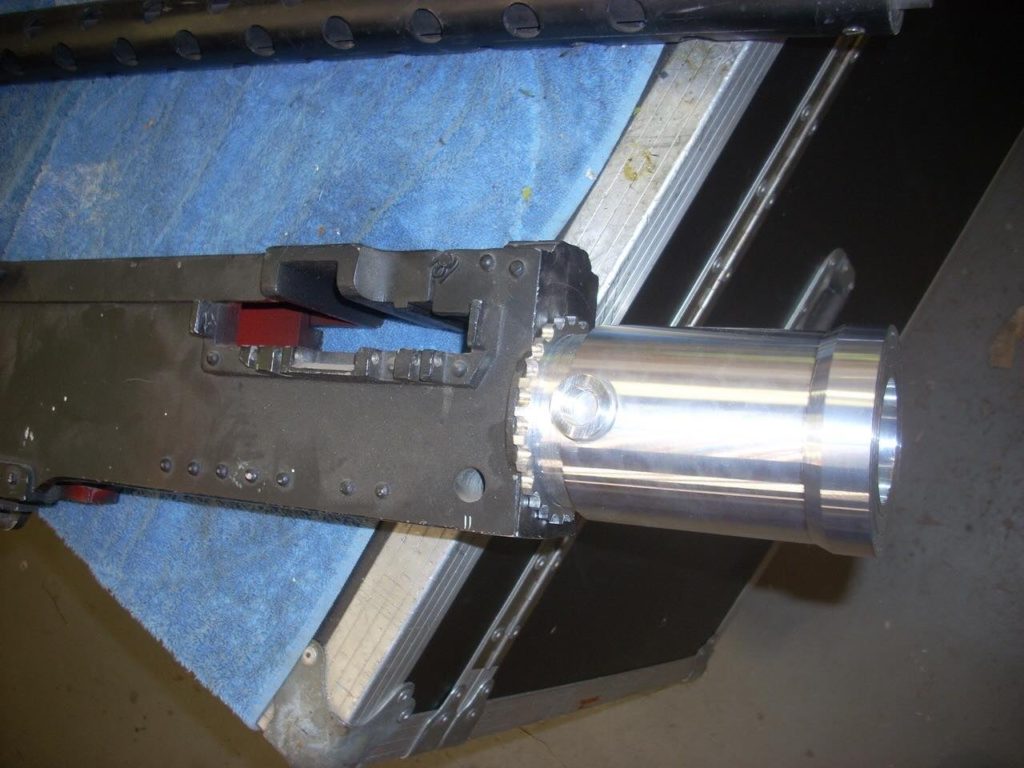
Bob Jacoby’s first Edgewater replica is fitted into place to check alignment.
The gun here is a replica from a private collection, but Bob has actually gone so far as to test fit his Edgewaters onto original .50 cal MGs.
Perfect.
Photo taken 26 April 2021.
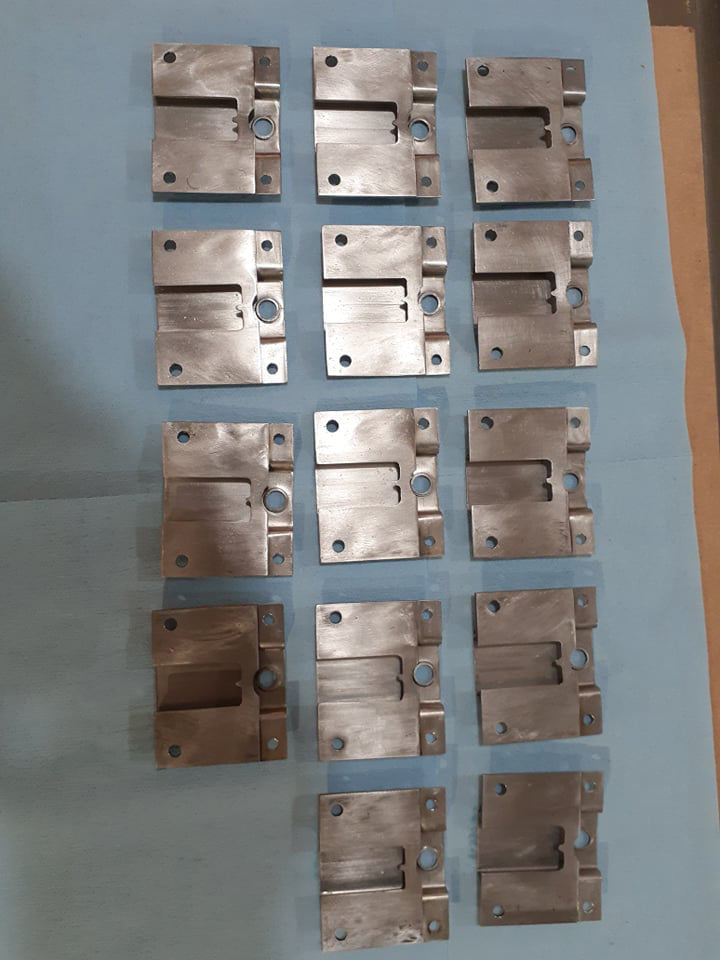
Bob Hachmann’s recently finished Boeing ammunition chute clips.
These came into service in September 1943, allowing armorers to quickly change chutes instead of having to bolt/unbolt them.
Photo taken 14 July 2021.

An employee of the United Airlines Modification Center at work.
A Boeing ammunition chute clip is highlighted here.
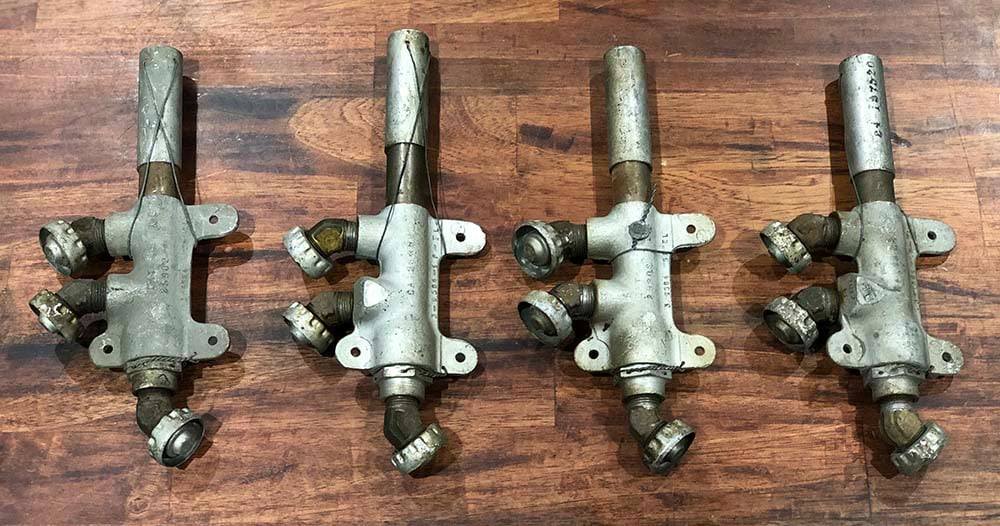
The newly arrived brake valves for Lucky Thirteen.
Photo taken 14 July 2021.

A brake valve is visible on the left side of this manual illustration of the B-17’s brake pedals.

The Q-1A rheostat heater newly located while sorting through the McKowen collection.
Need about a dozen more…
Photo taken 14 July 2021 after a good cleaning.
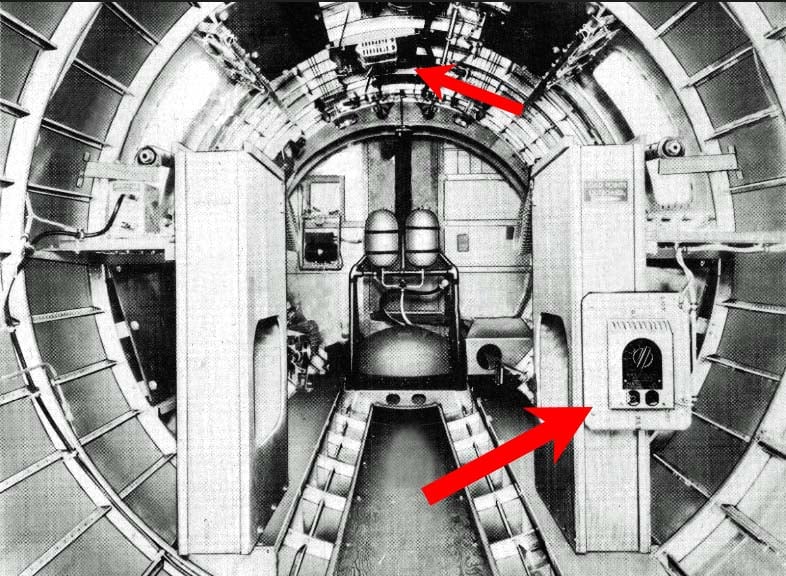
Q-1A Rheostat Heaters are highlighted in this manual illustration of a B-17F waist.

Newly recreated placards.
Top is the TU-5 Tuning Unit Calibration Chart. This chart is the same for all SCR-287 tuning units, with only the listed frequencies changing.
To the bottom left is the Compass Correction Card, with an original for comparison.
The Airspeed Calibration Card was recreated from an original photographed and sent to us.
Not shown but also recreated is the Altitude Correction Card.
We have yet to locate an original Temperature Correction Card.
Photo taken 14 July 2021.
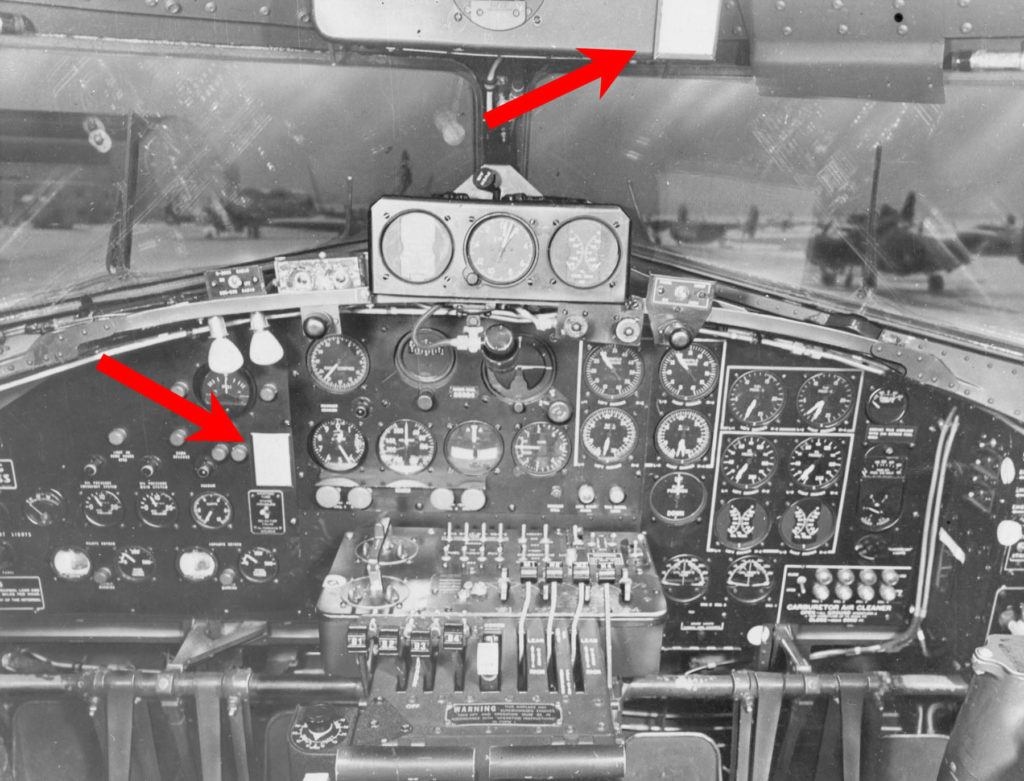
The Altitude Correction Card (left) and Compass Correction Card (right) are highlighted in this photo of a B-17F cockpit.
